#laser-focused pinterest audience targeting
Explore tagged Tumblr posts
Text
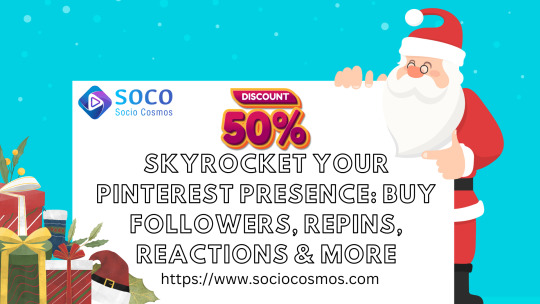
#pinterest follower growth service#buy pinterest board followers#get more engagement on pinterest#make my pins go viral on pinterest#organic pinterest growth strategies#targeted pinterest marketing#authentic pinterest engagement#laser-focused pinterest audience targeting#increase website traffic from pinterest#build brand loyalty on pinterest#pinterest growth#pinterest marketing#pinterest followers#pinterest engagement#pinterest boards#pinterest pins#social media marketing#content marketing#organic traffic#brand building#how to get more real followers on pinterest#best strategies for pinterest virality#increase pinterest engagement organic#target ideal audience on pinterest#get more website traffic from pinterest pins#build your brand on pinterest with authentic engagement
1 note
·
View note
Text
4 Popular Social Media Marketing Mistakes and How to Avoid Them
When businesses lack the time to devote to their strategy, many social media marketing efforts fall flat. Regular posting, answers, and online presence will increase your interactions and assist spread the word about you. You must invest some effort in your pages if you want greater outcomes.
Another crucial distinction between social media success and failure is the focus. A laser-like focus on your business, your target audience, and how you want to engage with them is necessary for effective social media marketing.
Making Accounts on All Platforms
Do you have to be active on every social media site? Without a doubt. The essential elements to take into account when determining which social media platform you should be active in are your brand's industry, your target demographic, and your marketing objectives.
If your business is a B2B one, LinkedIn is more likely than Pinterest to produce fruitful outcomes. While Pinterest focuses more on showcasing original and customized material, LinkedIn is more concerned with fostering business relationships.
Failing to Identify target audience
Speaking to a broad audience can be highly ambitious and won't produce the desired outcomes. By riding trends, you might increase interaction on your content, but conversions are less likely to result.
It is simpler to create effective messaging that achieves results in line with your business objectives when you have a clear understanding of your target audience. To avoid wasting your resources and investments, you should concentrate your marketing efforts on those who are more likely to demonstrate an interest in your goods or services.
Not Analyzing Posted Data
Social media marketing requires ongoing monitoring of campaign performance in order to make necessary adjustments. You may decide where to concentrate your efforts and what kinds of postings are most effective for you by monitoring analytics.
Not Creating Engaging Content
Social media platforms are intended to be social, as their name suggests. This is what gives it its strength and potency. Instead of being a platform for direct sales, it's intended to foster relationships. In order to be social, you must monitor the engagement on your page. Participate in discussion threads, respond to queries, and send messages on every platform where you are active.
Working with an expert can give you more insight into your audience and how to engage them on social media. We have a team of award-winning social media marketing consultant experts ready to help you grow your business.
#Social Media Marketing#Social Media Marketing Tips#Social Media Marketing Mistakes#Social Media Marketing Planning
0 notes
Text
Unleash Your Pinspiration: Ignite Explosive Growth with SocioCosmos
Feeling lost in the vast Pinterest landscape? Struggling to climb the engagement ladder? SocioCosmos is your rocket fuel! We blast your Pinterest presence into the stratosphere, delivering targeted growth that ignites real results.

Ditch the generic strategies and ghost followers. SocioCosmos offers potent concoctions tailored to your unique goals:
Fan Frenzy: Attract magnetic followers who adore your content and actively spread the Pinspiration. Watch your reach explode like a supernova!
Boardroom Blitz: Ignite your boards with engaged enthusiasts who pin, share, and champion your creations. Amplify your voice and become the ultimate curator.
Reaction Revolition: Spark a wildfire of authentic Likes, Comments, and Saves. Build brand loyalty and foster genuine conversations that captivate your audience.
Repin Rhapsody: Unleash an avalanche of viral repins with laser-targeted placements. Your pins will become irresistible, dancing their way across Pinterest feeds.
But here's the secret ingredient: SocioCosmos doesn't just sprinkle on numbers, we cultivate vibrant communities. Every follower, reaction, and repin is:
Real Deal: No bots, no ghost towns, just passionate humans who align with your niche.
Laser-Focused: We matchmake your content with ideal audience magnets, guaranteeing engagement that converts.
Sustainable Growth: Our organic growth strategies fuel your purchased boost, creating a lasting impact that keeps your Pinspiration burning bright.
Ready to dominate the Pinterest universe? Here's your cheat sheet to success:
Customizable Packages: Mix and match our potent growth boosters to fit your goals and budget.
Effortless Ascension: Sit back and watch your presence soar. Our seamless delivery guarantees risk-free results with our satisfaction shield.
Expert Support: Our dedicated team is your secret weapon, guiding you every step of the way.
Don't settle for slow, organic climbs. Invest in your Pinterest dream and witness explosive growth with SocioCosmos. Visit us today and unlock the full potential of your Pinspiration!
#Pinterest growth service#Pinterest engagement growth#Buy Pinterest followers#Get more Pinterest repins#Increase Pinterest traffic#Pinterest marketing services#Pinterest social media promotion#Organic Pinterest growth strategies#Targeted Pinterest audience reach#Pinterest community building#Pinterest follower engagement#Pinterest viral pins#Explode Pinterest reach#Skyrocket Pinterest growth#Pinterest board optimization#Pinterest reaction boost#Repin magnet service#Pinterest ad management#Authentic Pinterest followers#Targeted Pinterest growth campaigns#Buy real Pinterest followers with high engagement#Get repins on my new fashion board#Grow Pinterest organically in 2024#Increase website traffic from Pinterest#Target millennial audience on Pinterest#Buy Pinterest reactions for product launch#Make my pins go viral on Pinterest#Run successful Pinterest ad campaigns#Get more qualified leads from Pinterest#Build a loyal community on Pinterest
0 notes
Text
Getting Began With Your First Pinterest Advertisements Marketing campaign: Step-by-Step
New Post has been published on http://tiptopreview.com/getting-started-with-your-first-pinterest-ads-campaign-step-by-step/
Getting Began With Your First Pinterest Advertisements Marketing campaign: Step-by-Step

Who Will You Discover on Pinterest?
Are Pinterest Advertisements Proper for Your Enterprise?
Pinterest Advertisements Marketing campaign Set-Up & Technique
Study Pinterest Advertisements Concentrating on
Advert codecs
Pinterest Inventive Greatest Practices
Last Ideas
Pinterest is completely different from different paid media platforms in that it’s a visible discovery engine.
When you’re one of many many firms that also haven’t leveraged the chance to attach with audiences utilizing Pinterest Advertisements, this text is for you.
On this put up, we’ll cowl the individuals and the platform, focusing on alternatives, and suggestions for set-up.
Who Will You Discover on Pinterest?
The individuals on Pinterest are as various because the pins they create, and 95% of Pinners state that Pinterest conjures up them/offers them concepts for his or her life.
This various assortment of persons are able to take motion and discover one thing new. Over 80% use it for buy inspiration or precise purchases, which is essential to remember as you construct methods across the idea of inspiring adverts and messaging.
Pinterest promoting is accessible in at least 20 nations.
Every month, 459 million individuals use Pinterest to search for recipes, plan holidays, analysis what to purchase, and extra. Pinners are energetic in looking for out and exploring concepts.
Pinterest has a 20% market share of all US social media in terms of month-to-month visits, which doesn’t look like a lot till you think about it’s truly ranked #2 behind Fb, which has 60% of U.S. visits in January 2021.
It’s not simply Individuals pinning, both. Though the biggest variety of customers (over 100 million) are within the U.S., Pinterest Advertisements can attain customers everywhere in the world.
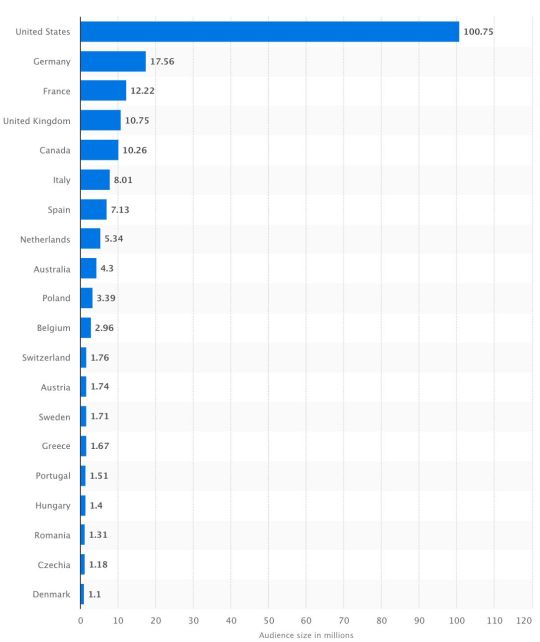

Supply: Statistica 2021
Commercial
Proceed Studying Beneath
Are Pinterest Advertisements Proper for Your Enterprise?
There are lots of of classes on Pinterest, with some tremendous in style classes. In case your services or products don’t slot in completely with the broad classes, you could have a complimentary product affinity with one.
For instance, residence enchancment can vary from a big-box retailer to an area companies supplier.
Common classes:
Expertise.
Residence enchancment, décor, design.
Vogue.
Meals + drink lover.
Magnificence.
Journey.
Pinterest Advertisements Marketing campaign Set-Up & Technique
To get began with adverts, a enterprise account is required at adverts.pinterest.com.
Pinterest will stroll you thru varied choices when creating a brand new marketing campaign.
The marketing campaign supervisor prompts you to decide on one marketing campaign goal of three targets that mirror the gross sales funnel:
Construct consciousness: Model consciousness, video views to assist individuals uncover the model.
Drive consideration: Gasoline consideration by getting extra individuals to click on your advert on Pinterest.
Get conversions: Drive individuals to take motion on the web site or buy from a purchasing advert.
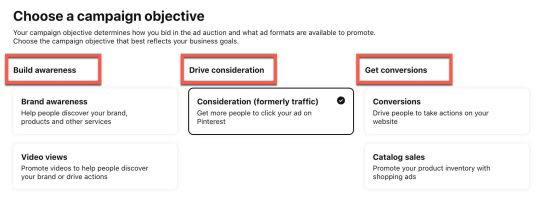

Pinners’ Journey
As a visible discovery engine, Pinners begin their buy journey with “just looking,” gathering concepts as much as, “I know what I want,” and looking for out particular merchandise.
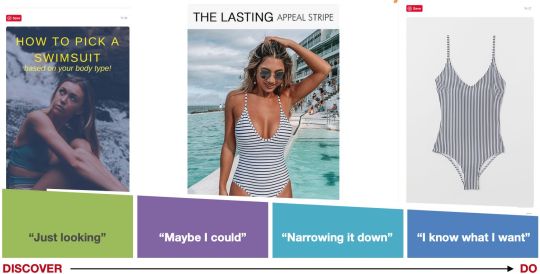

Supply: Pinterest
Commercial
Proceed Studying Beneath
Once more, this seems to be lots just like the outdated gross sales funnel and the marketing campaign goal you’ll select while you get began.
Since there may be one goal per marketing campaign, choose focusing on and inventive that meets that purpose and the cease within the pinner’s journey.
Utilizing each model consciousness and conversion campaigns individually to achieve your viewers at completely different phases within the gross sales funnel is an effective beginning technique for nearly any kind of enterprise.
Study Pinterest Advertisements Concentrating on
Subsequent, you’ll choose focusing on to your adverts, by:
Pursuits.
Key phrases.
Demographics.
Placements.
Expanded focusing on choices (viewers focusing on/retargeting).
Pinterest recommends focusing on advert teams to both pursuits + key phrases OR audiences to individually goal the 2.
Determine Search Developments
Pinterest has a nifty instrument for figuring out search pattern site visitors on their website within the US, UK, Canada.
You’ll be able to enter a number of search phrases and Pinterest will chart them on a graph in opposition to each other in phrases to point out searches over time.
Commercial
Proceed Studying Beneath
You could find this instrument within the Pinterest Advertisements account underneath Analytics > Developments.
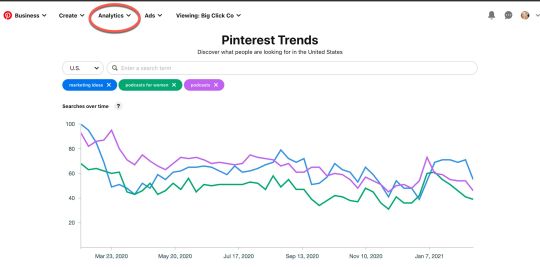

Pursuits
Select from a wide array of pre-defined pursuits associated to your model. Intention for 2 to 3 curiosity attributes per marketing campaign.
Because the pursuits are chosen, the potential viewers measurement is estimated on the right-hand aspect. Pinterest recommends an viewers measurement within the 1 to five million vary.
Key phrases
Use Pinterest’s key phrase instrument to find key phrase concepts based mostly on searches on Pinterest. Additionally they permit key phrase match to broad, phrase, and actual, just like different search platforms.
Commercial
Proceed Studying Beneath
You could discover the key phrases advised are broader such as you may anticipate in a website search, relatively than search engines.
Couple key phrases with pursuits, as these focusing on strategies work effectively collectively.
Demographics
Subsequent, you’ll be able to choose demographics.
Pinterest recommends that it’s greatest to not restrict focusing on with demographics except the services or products has constraints, resembling age or gender constraints.
Audiences
To focus on audiences, they have to first be created after which utilized to campaigns. There are 4 major viewers sorts that may be outlined and refined for extra superior campaigns:
Web site guests: Retargeting guests who’ve been in your web site.
Engagement viewers: Engaged with pins.
Buyer checklist: Add a lead checklist to focus on.
Actalike focusing on: a.okay.a., look-alikes or related audiences, these are Pinners who behave equally to lists you have already got.
These checklist sorts create nice alternatives to drive motion by the gross sales funnel and the Pinner’s journey.
Advert codecs
Pinterest Advertisements are served on Pinterest.com or on their app. Due to this fact, the entire advert codecs fall into pin format:
Commercial
Proceed Studying Beneath
rule of thumb is to make use of static pins and video pin artistic sorts in separate advert teams.
Pinterest has a guide on the specs for each ad type.
Pinterest Inventive Greatest Practices
Though we don’t go into particulars for the advert artistic right here, there are some overarching ideas used to develop a method:
Inspirational Content material.
Distinctive Name to Motion.
A number of Merchandise.
Developments and Seasonality.
Influencers and Way of life.
Last Ideas
With a 20% market share and laser-targeting for distinctive audiences, Pinterest might be an ideal second-tier platform to check for 2021.
Commercial
Proceed Studying Beneath
Think about these three issues:
How does your enterprise match into in style classes on Pinterest?
How are you going to attain your viewers at every stage of buy?
How are you going to encourage Pinners to interact and convert?
Extra Assets:
Picture Credit
All screenshots taken by writer, February 2021
if( !ss_u )// end of scroll user Source link
0 notes
Text
4 Overlooked Ways to Increase Your Website's Search Engine Rankings
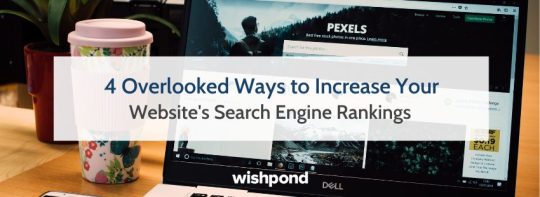
Publishing long-form content, building backlinks, optimizing your site speed and title tags, and so on — you’re aware of the fundamental best practices. While implementing these search engine optimization (SEO) techniques is all fine and dandy, all your competitors are doing the same.
So when it comes to outranking your competitors on Google, you don’t have an upper hand over your competition. Or, do you?
You see, there are some lesser-used tactics that you can leverage to accelerate the process of ranking your website at the top of Google SERPs. And most, if not all, of your competitors would likely be oblivious to these techniques.
Here are four such lesser-known yet well-founded ways to boost your website’s search engine rankings.
1. Optimize Content for Featured Snippets and “People Also Ask”
While attaining the very first spot on Google SERPs is a herculean task, what if you can attain a spot above the first one (the “zeroth” position) with relatively lesser amounts of effort? This so-called “position zero” or featured snippet shows up as a little box that contains the exact answer to the search query, typically in a question format.
The featured snippet is located above the first organic search result, which makes it a great place to be.

And usually, right below the snippet lies the “People Also Ask” (PAA) section that contains the most frequently asked user questions related to that search query. Google provides answers to these questions by extracting relevant bits of content from various websites, with a link (on the title) at the bottom of the answer.
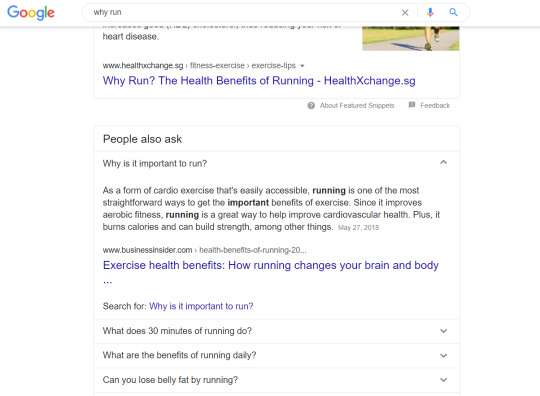
While typically towards the top, the PAA section can also be located between two positions (say, fifth and sixth) or at the bottom of the page. Regardless, it is on the first page of SERPs which makes it important for SEO.
Most search marketing experts are cognizant of the value of featured snippets and PAA, but few try to capitalize on them. In a nutshell, here’s how you can take advantage of this frequently untapped opportunity to get on the first page of Google:
Perform thorough keyword research and try to answer all question-type search queries in your content.
Create long-form (comprehensive) content and cover all long-tail keywords.
In your answers, aim for the optimal word count (featured snippets ordinarily range from 40-50 words).
Build an FAQ section on your blog or website.
Besides, optimizing your content for featured snippets and PAA also helps you rank for mobile voice searches (which 27% of the global online population is using), as voice searches are mostly done in a question-like format.
2. Ensure Website Accessibility
Simply put, an accessible website is one that accommodates all visitors on all devices no matter the physical or mental ability of the user.
And whether you like it or not, having an accessible website is mandatory. The Americans with Disabilities Act (ADA) applies to digital properties too, which means your website must be readily usable by visitors with disabilities (such as the visually impaired).
However, website accessibility is important not just to avoid ADA lawsuits but to improve your search rankings and reach new audiences.
With an estimated 26.9 million adult Americans claiming that they either have trouble seeing or are unable to see at all, it’s likely that a substantial chunk of your target audience is being shunned from doing business with you if you’re not having an accessible website.
Now, there’s a lot you can do yourself to improve your site’s accessibility:
Make sure there’s adequate color contrast on every page of your website.
Write an alt text for each image.
Include closed captions for videos.
Make your site keyboard-friendly.
Write detailed anchor texts for hyperlinks.
Design a logical content hierarchy (using subheadings H2, H3, and so on).
Add descriptive labels to form elements.
Publish an accessibility statement declaring your website’s target level of accessibility.
To ensure the highest level of accessibility and full ADA compliance, consider using a web accessibility platform that’s capable of scanning your entire website and making all elements compliant with the WCAG 2.1 (Web Content Accessibility Guidelines) published by the World Wide Web consortium.
Better accessibility translates to better user experience (UX) for everyone, and more credibility as a business — things that Google takes very seriously when ranking a website. Thus, if your website is accessible, it indirectly leads to better rankings on Google.
3. Optimize for Image Search
Most websites striving to achieve first-page rankings are laser-focused on ranking in the “All” tab. What they don’t realize is that there’s a lot of SEO potential in adjacent tabs such as “Images” as well, and ranking here translates to better rankings in the “All” tab.

In fact, the trend of visual searches is booming as we speak — 62% of Generation Z and Millennial consumers want visual search capabilities, more than any other new technology.
What’s more, in early 2018, Google Images accounted for roughly 22.6% of all internet searches, which means capturing this share of searches enables you to win a huge chunk of your audience.
The best part is that ranking for image searches is comparatively easy. Here are some best practices to follow when using images on your website:
Upload high-quality unique images instead of humdrum stock photos that everyone’s using.
Compress all images using a tool like TinyPNG to boost your site speed while maintaining quality.
Have a descriptive image file name to help the search engine crawlers better understand it.
Write a descriptive alt text to improve usability and further assist the search crawlers.
Add images to your sitemap so the search bots can easily crawl and index your images.
Create image structured data so Google displays your images as rich results in the “All” tab.
Furthermore, it’s a great idea to invest in videos for marketing your business. However, creating quality videos does require substantial time, effort, and money. If you wish to leverage video for better rankings and brand visibility without investing too much, consider these video formats:
Screencast tutorials and presentations
Behind-the-scenes of your business
Interviews with industry experts
Client testimonials
Seeing just how effective video is in digital marketing and how people are craving more and more video content today, it makes sense to start creating video content for your business as early as you can.
While on the subject of images and videos…
4. Repurpose Content Into Multiple Formats
It’s no news that blogging and content marketing is key to ranking your business on Google. But your competitors likely aren’t going above and beyond to reuse the same piece of text-based content in different formats so as to extract the most marketing juice out of it.
That’s what content repurposing is — recycling your existing content into different formats such as infographics, videos, ebooks, podcasts, presentations, etc. — in order to reach new audiences while giving Google more stuff to crawl and index.
For example, it is possible that a substantial portion of your target audience prefers watching videos over reading blog posts. Consequently, if you convert your blog posts into quick vlogs, you may be able to garner the attention of that audience segment.
Likewise, you can turn individual blog posts into infographics for better shareability, or collate posts on a single subject into a downloadable ebook.
Besides improving the usability of your content, repurposing enables you to rank for the same content for different search queries, not just on Google but also on social media platforms such as Pinterest for infographics, Instagram for photos, LinkedIn for presentations, YouTube (the second most popular search engine) for videos, and so on.
Thus, the search engine visibility of your content (and thus, your website) goes up dramatically as there’s more content to be crawled and indexed by the bots.
Final Thoughts
The tactics discussed above are often unheeded by even the most experienced search marketing professionals, which means your business can certainly gain an edge provided you implement these alongside the fundamental SEO best practices.
Do you have any obscure SEO techniques of your own that you swear by and don’t mind sharing? Feel free to share your thoughts in the comments below!
About the Author

Gaurav Belani is a senior SEO and content marketing analyst at Growfusely, a content marketing agency specializing in content and data-driven SEO. He has more than seven years of experience in digital marketing. He likes sharing his knowledge in a wide range of domains ranging from marketing to human capital management. His work is featured in several authoritative business publications.
from RSSMix.com Mix ID 8230801 https://ift.tt/3iMhEUx via IFTTT
0 notes
Text
What Is Social Media Marketing? And it’s Advantages and Importance?

1. What Is Social Media Marketing?
media marketing refers to the process of gaining traffic or attention through social media sites.Social

2. How Are Search & Social Media Marketing Related?
Why would a search marketer — or a site about search engines — care about social media? The two are very closely interconnected.
Social media often feeds into the discovery of new content such as news stories, and “discovery” is a search activity. Social media can also help build links that in turn support into SEO efforts. Many people also perform searches at social media sites to find social media content. Social connections may also impact the relevancy of some search results, either inside a social media network or at a ‘mainstream’ search engine.
3. Social Media Marketing At Marketing Land
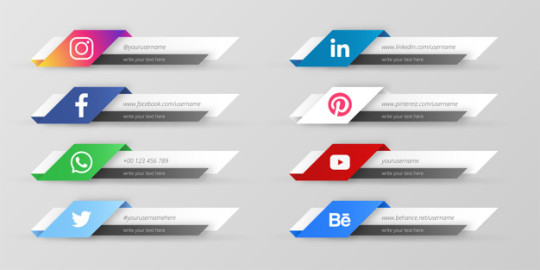
Marketing Land is the sister site to Search Engine Land that covers all facets of internet marketing, including these popular topics inside social media marketing:
Facebook
Instagram
Twitter
Pinterest
Linkedin
YouTube
4. What are the Advantages of social media marketing?
Below is few main benefits you can expect to gain the from use of social media for your brand. LYFE Marketing, A Social Media Management Company, drives results like these for our clients all the time. And your business can too. All you have to do is put the time and thought into it.
(1) Advanced Targeting - The exact audience that your business is targeting is on social media. You can find them based on what they are talking about and the data that is associated with their profiles. This is a huge advantage for brands with a niche or local market. Use social media as a way to find your customers and solve any wants or problems they may have. You will discover more tips on how to find your target audience.
(2) Direct Access to Customers - Social media authorize you to connect with your target market, prospects, and customers at any time. In fact, some platforms allow you to import your contacts into your account to connect with them. You can use this as a way to immediately inform your customers on current promotions, special offers, new products, and more. And best of all its free. This is a great way to up sale your current base.
(3) Brand Awareness – Social media authorize you to market your business to thousands of people around the world at any moment. There is no limit to the demographic, location, or type of consumer that your brand can touch. Every time someone shares one of your post, your reach grows larger. For example, if your tweet gets shared by 20 people who average 500 followers, then up to 10,000 people have the ability to see your post! Thats pretty good.
(4) Lower Advertising Cost – Let’s face it. It cost more to print flyers than to make a post on social media. There are Facebook ad campaigns that reach more people than billboards. YouTube, which is the second largest search engine in the world, can be more cost effective than network TV ads. Social media allows brands to be laser focused and spend less on advertising.
(5) Increase Relationship Capital – For the first time in history, brands have the opportunity to build relationships online through social media. For brands on social media, it means to build a bond within the market you are targeting. People tend to buy from brands they know and trust. You must first look to connect with your customers on a personal level and look to sell lasts.

5. why social media marketing is important for your business?
Social media is speedily becoming one of the most important aspects of digital marketing, which provides incredible advantages that help reach millions of customers worldwide. And if you are not applying this profitable source, you are missing out an incredible marketing opportunity, as it makes it easy to spread the word about your product and mission.
(1) Improved brand awareness
Social media is one of the most stress-free and profitable digital marketing platforms that can be used to increase your business visibility. To get started, create social media profiles for your business and start networking with others. By applying a social media strategy, it will help you significantly increase your brand recognition. By spending only a few hours per week, over 91% marketers claimed that their social marketing efforts greatly increased their brand visibility and heightened user experience. Undoubtedly, having a social media page for your brand will benefit your business and with a regular use, it can also produce a wide audience for your business in no time.
(2) Cost-effective
For an advertising strategy, social media marketing is possibly the most cost-effective way. Creating an account and signing up is free for almost all social networking platforms. But if you decide to use paid advertising on social media, always start small to see what you should expect. Being cost-effective is important as it helps you attain a greater return on investment and hold a bigger budget for other marketing and business payments. Just by investing a little money and time, you can significantly increase your conversion rates and ultimately get a return on investment on the money that you primarily invested.
(3) Engage with your customers
Social media is a good way for engaging and interacting customers. The more you communicate with the audience, the more chances you have of conversion. Set up a two-way communication with your target audience so that their wishes are known and their interest is catered with ease. Moreover, communication and engagement with customers is one the ways to win their attention and convey them your brand message. Thus, your brand will reach more audience in real terms and gets itself established without any hassle.
(4) Improved brand loyalty
When you have a social media presence, you make it easier for your customers to find you and connect with you. By connecting with your customers through social media, you are more probable to upsurge customer retention and customer loyalty. Since developing a loyal customer base is one of the main goals of almost any business. Customer satisfaction and brand loyalty typically go hand in hand. It is essential to often engage with your customers and start developing a bond with them. Social media is not just limited to introducing your product, it is also a leading platform for promotional campaigns. A customer sees these platforms as service channels where they can directly communicate with the business.
(5) Healthier customer satisfaction
Social media plays a vital role in networking and communication platform. With the help of these platforms, creating a voice for your company is important in improving the overall brand image. Customers appreciate the fact that when they post comments on your page, they receive a modified reply rather than a computerized message. A brand that values its customers, takes the time to compose a personal message, which is perceived naturally in a positive light.
(6) Marketplace awareness
One of the best ways to find the needs and wants of your customers instead of directly communicating with them is Marketplace awareness. It is also considered as the most valuable advantage of social media. By observing the activities on your profile, you can see customers’ interest and opinions that you might not know otherwise if you didn’t have a social media presence. As a complementary research tool, social media can help you get information and a better understanding of your industry. Once you get a large following, you can then use additional tools to examine other demographics of your consumers.

(7) More brand authority
For making your business more powerful, brand loyalty and customer satisfaction both play a major role, but it all comes down to communication. When customers see your company posting on social media, especially replying to their queries and posting original content, it helps them build a positive image in their minds. Regularly interacting with your customers proves that you and your business care about them. Once you get a few satisfied customers, who are vocal about their positive purchase experience, you can let the advertising be done for you by genuine customers who appreciated your product or service.
(8) Increased traffic
One of the other benefits of Social Media is that it also helps increase your website traffic. By sharing your content on social media, you are giving users a reason to click-through to your website. On your social account, the more quality content you share, the more inbound traffic you will generate while making conversion opportunities.
#social media marketing#digital marketing#social media#digital india#advantages of social media marketing
0 notes
Text
5 Marketing Lessons from Daily Harvest’s Journey to Shipping One Million Smoothies
Launched in 2015, Daily Harvest has become one of the fastest growing direct-to-consumer food brands in the world.
In 2017, it raised over $43m — with investors like Gwyneth Paltrow and Serena Williams
It shipped over one million smoothies in just one year after launching nationwide in the U.S.
More than 100,000 customers now use its service
It’s an incredible story. But just how did Daily Harvest transition from solving a meal-prep problem for founder Rachel Drori to being in over 100,000 kitchens across the U.S.?
In this post, we take a look at some of the marketing strategies that have aided Daily Harvest’s incredible growth.
Contents: 5 Marketing Lessons from Daily Harvest
Lesson 1: Focus on target customers’ needs and create products to solve their problems
Lesson 2: Use Pinterest as a discovery engine to reach millions of potential customers each month
Lesson 3: Create a simple-to-navigate website and tell an engaging story to generate backlinks
Lesson 4: Use paid social to drive traffic to campaign-specific landing pages
Lesson 5: Build trust with new audiences through partnerships
1. Focus on target customers’ needs and create products to solve their problems
Before starting Daily Harvest, Rachel Drori worked in marketing for Jetsetter. She wanted to find a quick, convenient way to prepare her week’s meals on a Sunday, so she didn’t have to think about what she would eat during busy weekdays.
But after trying a number of options, nothing quite matched her needs.
“Meal kits are perishable, they go bad in your fridge, and they take 45 minutes to prepare,” she told Entrepreneur. “And all convenient food is preserved in some way.”
As we touched on in the intro, Daily Harvest was founded after Drori began to make meals in batch and freeze them. Something that no company seemed to be offering. Seeing a gap in the market, she pulled together a website and started selling to people who were experiencing the same meal prep problems she’d had.
The company has evolved a lot since those early days, but one thing that remains is its laser focus on serving a specific need for its target customers.
“Our target consumer is one who subscribes to a healthy lifestyle, but is busy and has time restrictions,” Drori told Business Insider.
Drori expanded on Daily Harvest’s target customer during an interview with Inc. “Our customer wants to eat the way he/shes knows he/she should, but struggles with the challenge of making it happen.”
“Our most common piece of customer feedback is that we’ve filled a need in the health food space that wasn’t previously being met. It works for the busy-bee or if you’re just looking for more nutrients in your diet but are unsure where to start.”
Consumer habits: The ease of buying healthy foods is one of the key pain points Daily Harvest solves. Shoppers want to buy healthier foods, but it’s not always easy — a survey of 1,017 U.S. consumers found that 95% of people ‘always’ or ‘sometimes’ look for healthy food options, but finding healthy food is only moderately easy for most consumers.
But why is it so important for Daily Harvest to focus on specific customers? Why doesn’t it try to entice everyone to eat a little healthier?
“Focusing on a specific customer segment is critical to sustaining long-term growth,” says DTC Strategist, Marco Marandiz.
“Organizations that get distracted easily by emerging, yet unaligned, segments end up burning through their resources and creating value that doesn’t resonate with their earliest customers,” continues Marandiz. “For Daily Harvest, it’s important for them to keep digging into their core customers to really fulfil their needs in the kitchen.”
Having a clear understanding of who its customers are, and the problems it solves for them has enabled Daily Harvest to craft messaging, content, and products that are aligned with exactly what the customer is looking for.
Right from the hero section of its homepage, you can see its focus on target customer needs and desires:
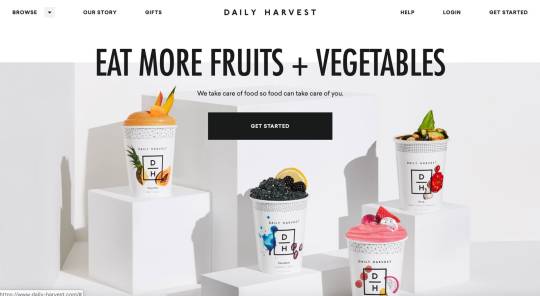
The heading ‘Eat More Fruits + Vegetables’ speaks to the target customers desire to boost their diet with healthy ingredients
The subheading ‘We take care of food so food can take care of you’ also taps into the same desires, but from a slightly different level, letting customers know that all the hard work — sourcing and preparing healthy foods — is done for them.
If you’ve ever interacted with the brand before the imagery on its site also feels incredibly familiar.
Daily Harvest has done a great job of creating its own unique brand style:
Crisp images of its packaging containing bold, brightly colored ingredients, photographed against a solid background. It also uses lighting to create shadows quite frequently.
Here’s its look on Instagram —
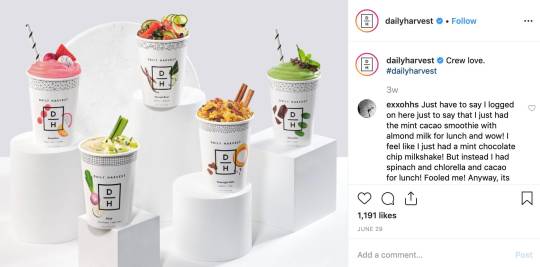
— and on a product page:
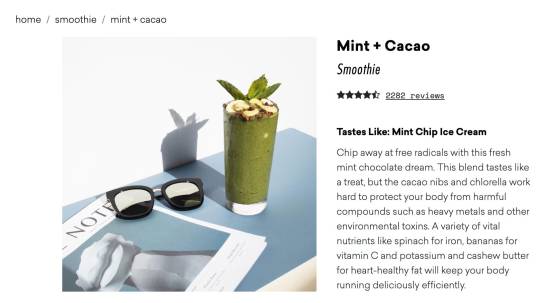
Expansion is also important for most DTC brands. Many launch with one or two specific products — for example, Casper mattresses — and expand into other related products in order to grow — Casper’s pillows and bed frames.
Daily Harvest is no different. It started out by selling frozen smoothie packs. But now it boasts a range of products.
And when it comes to launching new products, Daily Harvest ensures it keeps its focus on solving the problem of making healthy eating easier for consumers.
“It’s easy to observe their focus by taking stock of the product line expansions over the last couple years,” shares Marandiz. “They started with smoothies, but have moved into Harvest Bowls, Soups, Lattes, Chia Bowls, and Oat Bowls.”
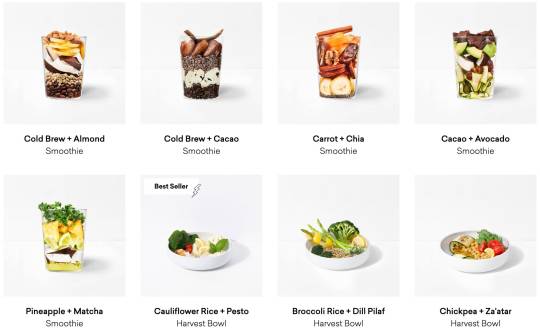
The messaging around each of its expansion products is also hyper-focused on customer goals.
Take its Harvest Bowls category page for example —
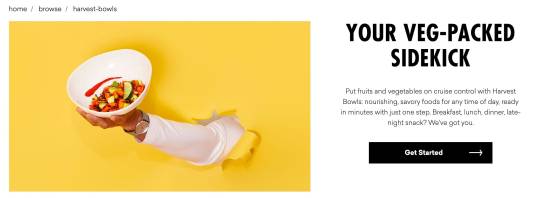
— the copy here continues to focus on the core mission of Daily Harvest: Making healthy eating simple. And no matter where you interact with the brand, that message remains consistent.
2. Use Pinterest as a discovery engine to reach millions of potential customers each month
Pinterest is somewhat of a sleeper in the social media world. And though it might not make as much noise as platforms like Facebook or Instagram, its power to help brands connect with consumers is undeniable.
In its S-1 filing ahead of going public, the company shared some insights into how people use the platform:
Pinners don’t just dream about their futures; they explore real options and often want to bring their dreams to life. They browse ideas, visit merchant websites and eventually buy products and services; and
People seeking inspiration use Pinterest in ways that mirror how they use magazines and catalogs.
So whereas consumers used to flick through magazines to find inspiration, they now turn to Pinterest — and this is why it has become such an incredible discovery engine for brands.
Daily Harvest has 5,638 followers on Pinterest. That doesn’t sound a lot, especially when compared to its audiences on Facebook (260k) and Instagram (406k). But follower numbers are just a small part of the equation.
On Pinterest, discoverability is far more important than the number of followers.
Daily Harvest racks up a mouthwatering 4.1m monthly unique viewers on Pinterest — meaning its Pins appear on over four million screens per month, and it does this having just 136 Pins.
Pinterest trends: Daily Harvest is in the perfect position to succeed on Pinterest. ‘Healthy habits’ is one of Pinterest’s trends for 2019, with searches for nutrition plans +475% year-on-year, showing that health-conscious consumers are using Pinterest to help them hit their goals.
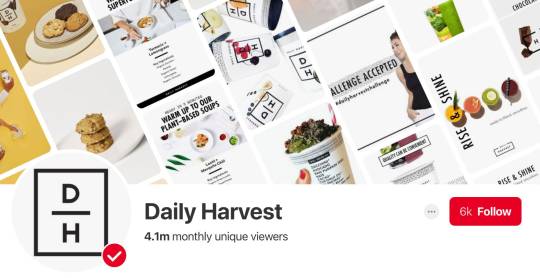
Its Pins tend to focus directly on Daily Harvest products in its brand style of stunning product imagery against a solid, light background:
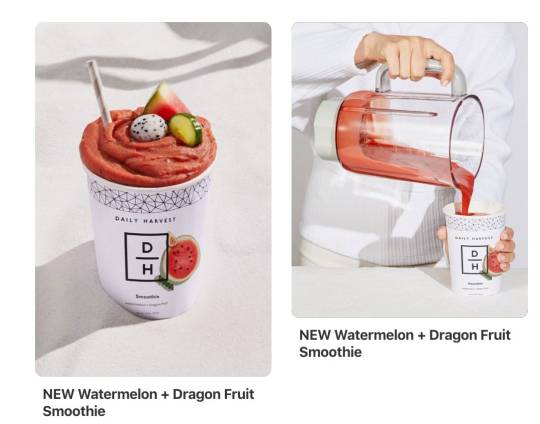
According to SimilarWeb data, Pinterest is Daily Harvest’s third-highest refer amongst social networks, driving around 13,000 visits per month —
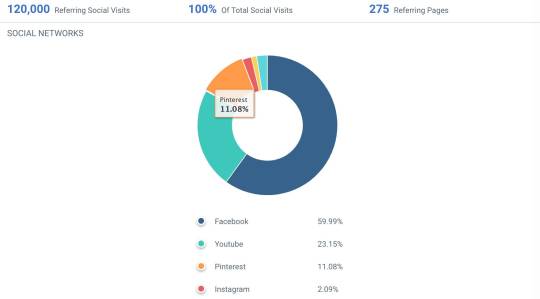
— and much of this traffic is going directly to product pages (the link on each Pin takes the viewer to the corresponding page):

3. Create a simple-to-navigate website and tell an engaging story to generate backlinks
SimilarWeb estimates that over 30% of Daily Harvest’s traffic comes from search —

— that’s a pretty large chunk, and if SimilarWeb’s estimates are correct, that search traffic equates to around 270,000 visits per month for the brand. That’s a lot of potential customers.
So what can we take away from Daily Harvest’s search success?
Firstly, usability and design are important:
“The design, first of all, is obviously incredible. While I never consider design to be a direct SEO factor, having a positive experience on a site does make you more likely to talk about and link to it,” says Glen Allsopp, SEO consultant and founder of Detailed.com.
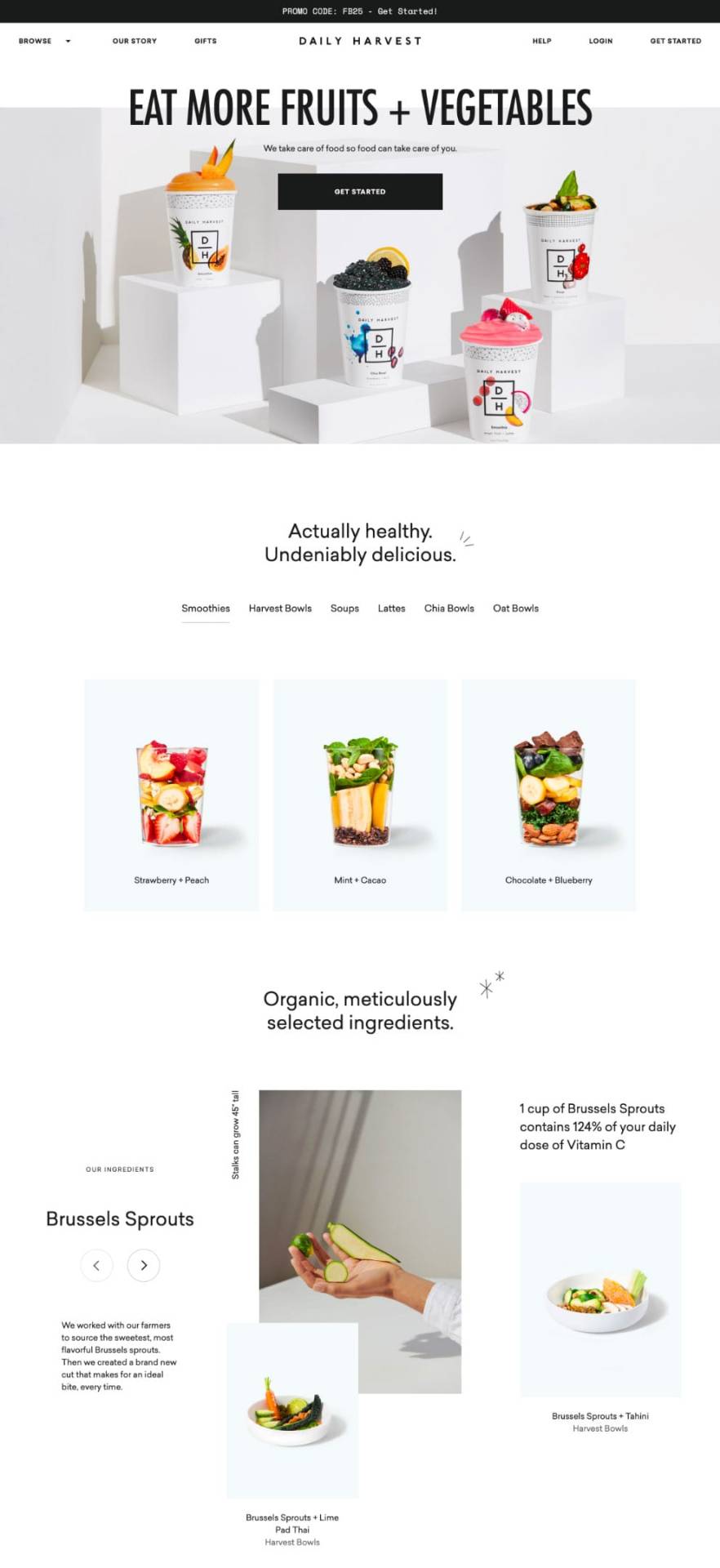
And Allsopp certainly isn’t alone in praising Daily Harvest’s design, Unbounce has also featured it in its roundup of companies that have created best-in-class landing pages.
But back to SEO…
Simplicity is somewhat of a theme for Daily Harvest across its website, content and even its products — pre-made, healthy meals that are ready in minutes.
And this theme carries over into its approach to SEO.
“I like that their URLs are short and descriptive, which is in line with their title tags as well,” notes Allsopp. “Title tags don’t get much more simple and clean than ‘Lentil + Mesquite Soup | Daily Harvest’.”
Daily Harvest also manages to include plenty of information on its product pages, something that’s not easy to do well Allsopp told me. First, each product has a short description right under the title —

— a little further down the page, visitors can see key ingredients, nutrition information and preparation instructions — essentially everything a customer would want to know about this product, without it feeling overwhelming:
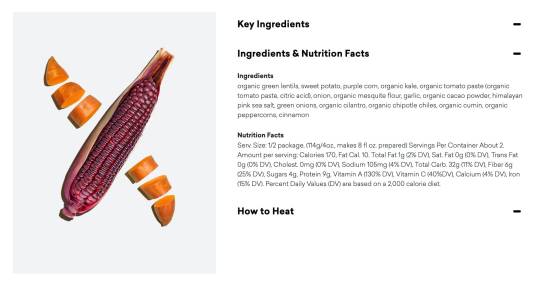
One downside to Daily Harvest’s beautiful imagery is the effect it has on load times. “According to Google’s mobile site speed comparison tool, it’s a lot slower than competitors sites,” Allsopp shared.
But with much of its search traffic coming in via branded searches, Daily Harvest has done a great job building its brand and creating a loyal customer base:
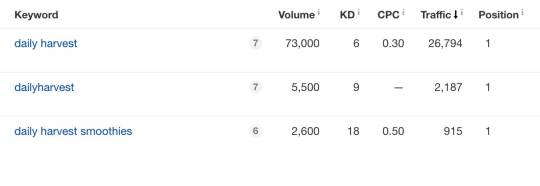
Possibly Daily Harvest’s biggest SEO-win is the quality of backlinks it has been able to obtain from leading publications — something that’s a challenge for almost every business.
Link building is one of the hardest aspects of SEO — and I have no insider knowledge here — but I’d bet Daily Harvest has never sent out a batch of emails asking marketers to backlink to its site.
Instead, it does link building the right way, by telling its story… and having a great product.
“Daily Harvest’s founder, Rachel Drori, has been great at getting quoted in big publications,” Allsopp told me. “Some places that have asked her for comment include CNBC and The New York Times. Those aren’t easy links to get, so they’re likely to help the site for a long time to come.”

Because its products are high-quality and deliver on what it promises, it’s enabled Daily Harvest to be featured by industry experts and pick up links from high-authority sites like MSN:
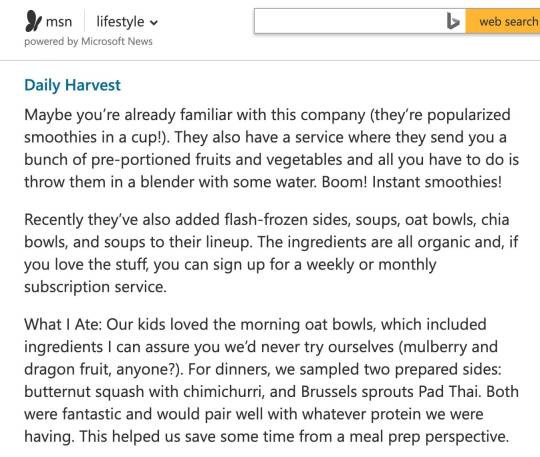
“While they still have improvements to make with their on-site SEO, that’s always a great position to be in. Seeing opportunities for improvement there means there’s a good chance of growing organic traffic across the board going forward as well,” said Allsopp.
4. Use paid social to drive traffic to campaign-specific landing pages
When Daily Harvest runs ads, it doesn’t direct people to its homepage. Instead, it has a specially created landing page aimed to convert visitors to customers.
This isn’t a unique strategy. In-fact, creating specific landing pages for ads is a best practice for any brand investing in paid media. But the way Daily Harvest executes it is remarkable.
Here’s one of the brand’s landing pages:
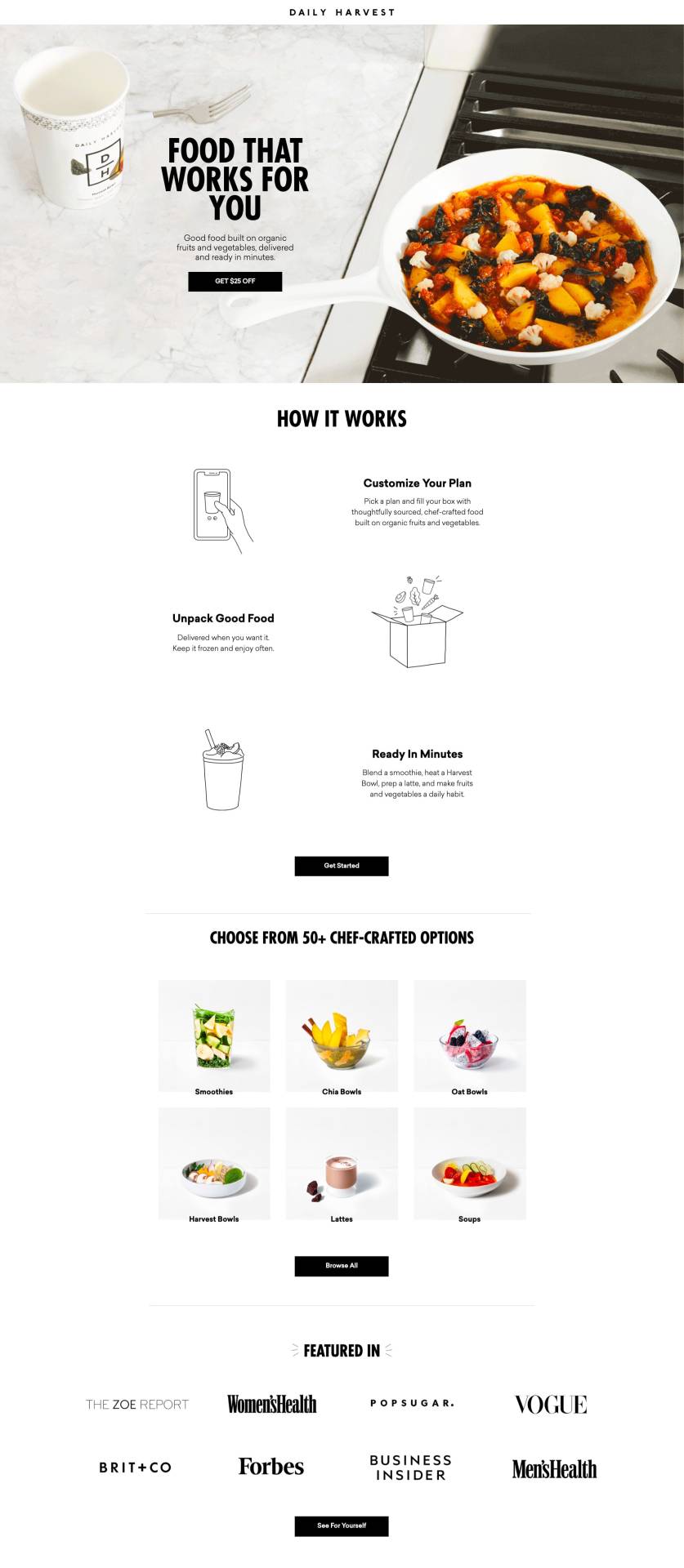
Keeping in line with Daily Harvest’s beautiful design aesthetic, the page looks super-clean and simple. But when you really dig in, there’s a lot going on.
Here are four takeaways from Daily Harvest’s landing page:
1. The hero copy builds on ad promises
Let’s start by breaking down the hero section at the top of the page:
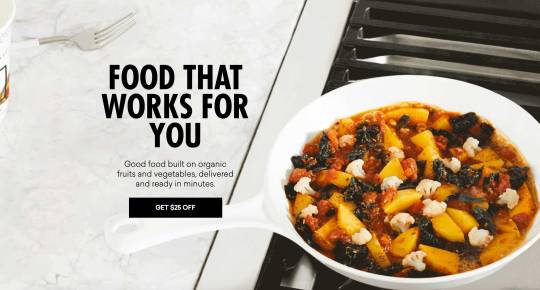
Daily Harvest is running a bunch of ads across Facebook and Instagram, and many of its ads are focused on these key messages:
Custom food plans
Quality, organic fruits and vegetables
Speed of preparation
Here are a few variations of that messaging in ad form:

Once someone has clicked one of these ads, they arrive at one of Daily Harvest’s landing pages and the copy builds on the key points mentioned in the ads. It reinforces that:
The food is high quality, and good for you
It’s ready in minutes
Health eating that fits your routine
2. The CTA offer is very clear
In each of its ads, Daily Harvest mentions that new customers can get $25 off their first box using a promo code —
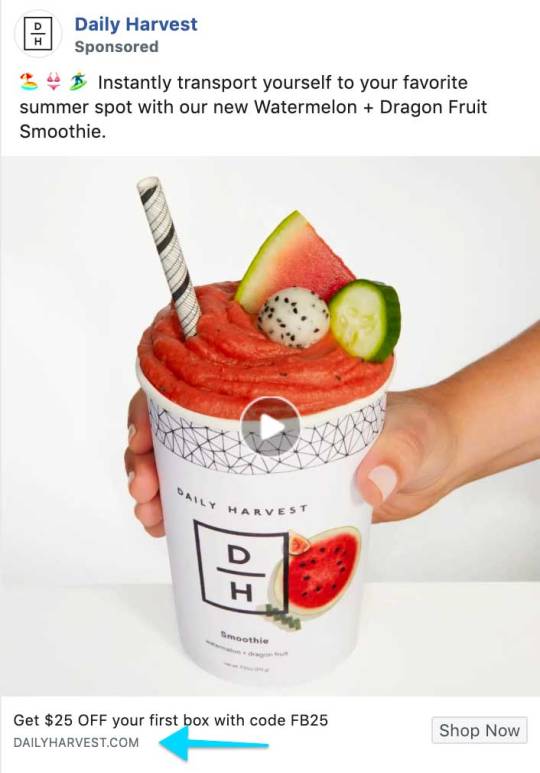
— and when they reach the landing page, this 25% offer is featured in the hero section CTA:
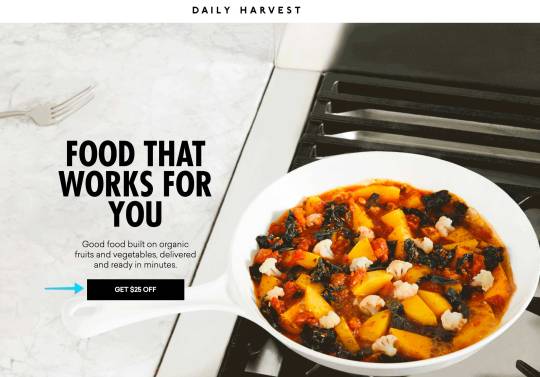
This makes the buyer journey feel super smooth as promises that were made in the first part of the journey (the ads) are being backed up as people move through the buying experience.
3. The copy is all about you, the customer
As the visitor scrolls through the landing page they reach a ‘How it works’ section:
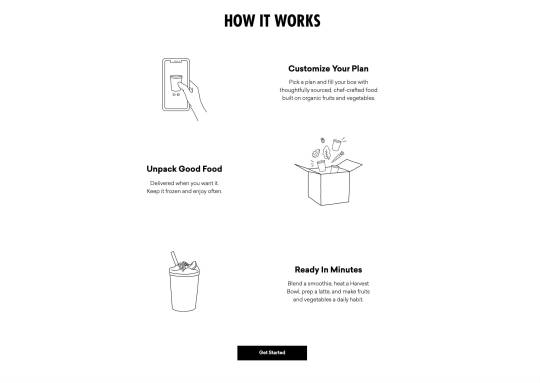
The first title tag ‘Customize Your Plan’ puts the emphasis on you, the potential customer, and throughout this section of the landing page the reader is constantly reminded that Daily Harvest is a product that can solve your unmet needs.
Here are a few snippets of copy (emphasis mine):
Pick a plan and fill your box with thoughtfully sourced, chef-crafted food
Delivered when you want it
Make fruits and vegetables a daily habit
This copy also fulfils a need to let the customer know exactly how the process works. Many visitors want a hassle-free way to consume healthier foods, but prior to visiting this page may not understand how Daily Harvest delivers on this.
Pay attention to the small details: Microcopy — the small pieces of text that provide extra information and provide context across websites and interfaces — is incredibly important, and can have a big influence on clicks and conversions.
For example, one company found that changing the phrase “Request a quote” to “Request pricing” resulted 161.66% increase in clicks to its lead gen form.
4. It uses social proof to back up its message
Social proof is a powerful sales tool and helps to build trust. As Alfred explains in his post on the subject:
“Often in situations where we are uncertain about what to do, we would assume that the people around us(experts, celebrities, friends, etc.) have more knowledge about what’s going on and what should be done.”
As a prospective Daily Harvest customer, I might not be an expert on healthy eating, I just know I want to eat healthier. So to back up its message, Daily Harvest features a range of well-known publishers that have covered its products to help build trust:

You’re more likely to put your faith in a health product featured by Men’s Health, Women’s Health and Vogue, than one no publisher has featured, right?
5. Build trust with new audiences through partnerships
Partnerships have become a key part of the direct-to-consumer marketing playbook.
Why?
In its simplest form, advertising is about connecting relevant audiences with your message. But when marketers focus purely on reach they run into a problem: reach has become a commodity — anyone can now create a Facebook ad and put it in front of an audience.
As Morgan Housel wrote —
Attracting eyeballs no longer sets you apart. Building trust among those who have their eyes on you, does. Getting people’s attention is no longer a skill. Keeping people’s attention is.
— and this is where partnerships come into their own: Building trust.
Let me explain…
When you follow a YouTuber, let’s say Casey Neistat, he’s built up your trust over hundreds (if not thousands) of hours of content and attention.
So when a brand like Samsung works with Casey, it helps the brand to build trust with Casey’s audience.
“If Samsung is cool with Casey, it’s cool with me.”

Daily Harvest takes a similar approach to partnerships….
YouTube drives significant traffic for Daily Harvest. You might recognize the below chart from earlier, but this time I’ve highlighted the YouTube numbers —
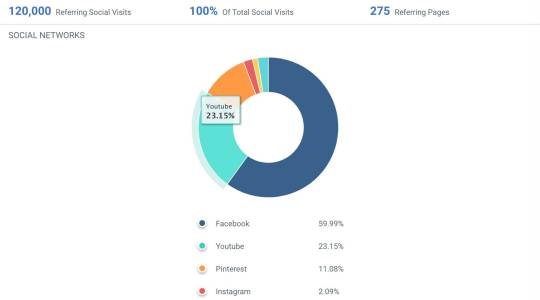
— around 23% of Daily Harvest’s social traffic comes from YouTube.
Curious as to why so many people come from YouTube to Daily Harvest I done a little digging… and it seems partnerships have a lot to do with it.
One the YouTube pages that appears to be sending a lot of traffic to Daily Harvest is from popular YouTuber, Wheezy Waiter (nearly 900k subs!):

The video (as you can probably guess from the above screenshot) is about the host’s experience trying out a vegan diet for a month.
And as the video progresses, the host runs into a problem with finding vegan desserts he likes. But Daily Harvest, the video’s sponsor, sent him 24 smoothies to help solve his problem:

Incredible product placement (this video has been watched 1.5 million times and counting) but it doesn’t end there. In the video description there’s a link to Daily Harvest’s website:
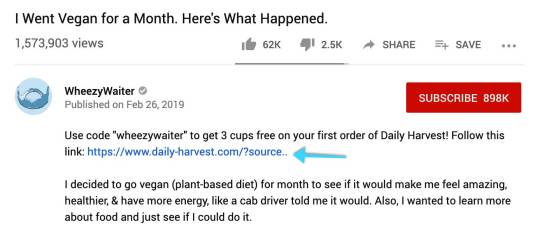
The link also has a UTM specific to Wheezy Waiter so the Daily Harvest team will be able to attribute traffic and sales to this partnership:
https://www.daily-harvest.com/?source=youtube&medium=cpc&campaign=inf&content=wheezywaiter&term=
Breaking down the UTM: Essentially, UTM codes tell the story of how traffic is arriving at a website. Here’s a breakdown of the Daily Harvest UTM:
source=youtube: This tells Daily Harvest the traffic has been referred by YouTube
medium=cpc: Says this was a cost-per-click campaign
content=wheezywaiter: Lets the Daily Harvest team know exactly which piece of content creator the traffic is came from
This is something Daily Harvest has done with a number of well-established YouTuber’s:
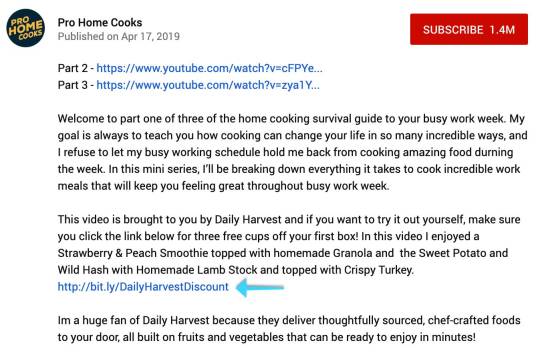
And:

But Daily Harvest’s partnerships aren’t limited to YouTube. It regularly runs Instagram takeovers with influencers and other brands in its stories —
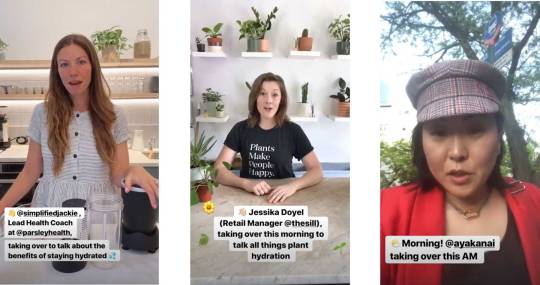
— and it also has an ambassador program enabling people with large followings to share exclusive discounts and coupon codes with their audiences:
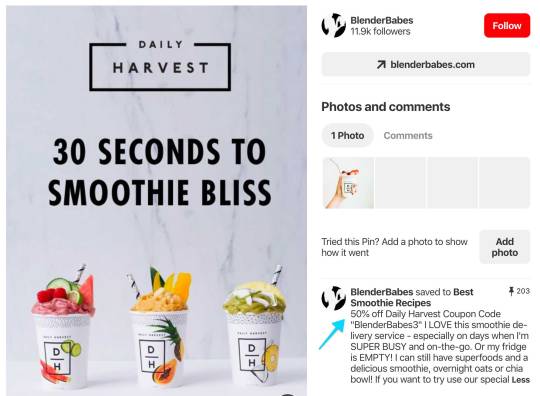
Daily Harvest is also very forthcoming with partnerships. Its website footer features a ‘Partnerships’ link:
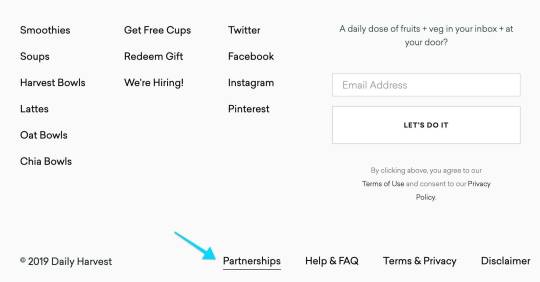
This link then takes people to a simple form where they can register their interest in working with the brand:
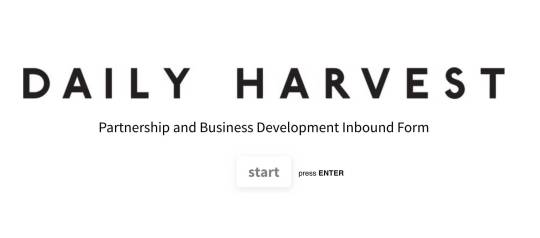
5 Takeaways from Daily Harvest’s journey to 100,000+ customers
1. Understand your target customer’s unmet needs:
Daily Harvest has a clear understanding of who its customer is exactly and what problems it solves for them. This influences how the whole business works: From its product lines to how it positions itself in the market.
2. Use Pinterest as a discovery engine:
Pinterest is a discovery engine for brands. People use Pinterest in ways that mirror how they use magazines and catalogs. By posting relevant content Daily Harvest reaches over four million people per month on the platform.
3. Create a beautiful, simple-to-use buying experience:
Consumers are spoilt for choice now, to stand out you need to create great experiences. Daily Harvest’s website does just that. Its focus on story has also helped the company to pick up some very important backlinks.
4. Drive paid social traffic to specific landing pages:
When using paid acquisition channels (especially on social media), Daily Harvest links to specific landing pages that build on the promises made in the ads.
5. Unlock new audiences through strategic partnerships:
When you’re marketing to new audiences, it’s not so much about reach as it is building trust. Daily Harvest works with partners and influencers to help it establish trust with new potential customers.
5 Marketing Lessons from Daily Harvest’s Journey to Shipping One Million Smoothies published first on https://improfitninja.weebly.com/
0 notes
Text
5 Marketing Lessons from Daily Harvest’s Journey to Shipping One Million Smoothies
Launched in 2015, Daily Harvest has become one of the fastest growing direct-to-consumer food brands in the world.
In 2017, it raised over $43m — with investors like Gwyneth Paltrow and Serena Williams
It shipped over one million smoothies in just one year after launching nationwide in the U.S.
More than 100,000 customers now use its service
It’s an incredible story. But just how did Daily Harvest transition from solving a meal-prep problem for founder Rachel Drori to being in over 100,000 kitchens across the U.S.?
In this post, we take a look at some of the marketing strategies that have aided Daily Harvest’s incredible growth.
Contents: 5 Marketing Lessons from Daily Harvest
Lesson 1: Focus on target customers’ needs and create products to solve their problems
Lesson 2: Use Pinterest as a discovery engine to reach millions of potential customers each month
Lesson 3: Create a simple-to-navigate website and tell an engaging story to generate backlinks
Lesson 4: Use paid social to drive traffic to campaign-specific landing pages
Lesson 5: Build trust with new audiences through partnerships
1. Focus on target customers’ needs and create products to solve their problems
Before starting Daily Harvest, Rachel Drori worked in marketing for Jetsetter. She wanted to find a quick, convenient way to prepare her week’s meals on a Sunday, so she didn’t have to think about what she would eat during busy weekdays.
But after trying a number of options, nothing quite matched her needs.
“Meal kits are perishable, they go bad in your fridge, and they take 45 minutes to prepare,” she told Entrepreneur. “And all convenient food is preserved in some way.”
As we touched on in the intro, Daily Harvest was founded after Drori began to make meals in batch and freeze them. Something that no company seemed to be offering. Seeing a gap in the market, she pulled together a website and started selling to people who were experiencing the same meal prep problems she’d had.
The company has evolved a lot since those early days, but one thing that remains is its laser focus on serving a specific need for its target customers.
“Our target consumer is one who subscribes to a healthy lifestyle, but is busy and has time restrictions,” Drori told Business Insider.
Drori expanded on Daily Harvest’s target customer during an interview with Inc. “Our customer wants to eat the way he/shes knows he/she should, but struggles with the challenge of making it happen.”
“Our most common piece of customer feedback is that we’ve filled a need in the health food space that wasn’t previously being met. It works for the busy-bee or if you’re just looking for more nutrients in your diet but are unsure where to start.”
Consumer habits: The ease of buying healthy foods is one of the key pain points Daily Harvest solves. Shoppers want to buy healthier foods, but it’s not always easy — a survey of 1,017 U.S. consumers found that 95% of people ‘always’ or ‘sometimes’ look for healthy food options, but finding healthy food is only moderately easy for most consumers.
But why is it so important for Daily Harvest to focus on specific customers? Why doesn’t it try to entice everyone to eat a little healthier?
“Focusing on a specific customer segment is critical to sustaining long-term growth,” says DTC Strategist, Marco Marandiz.
“Organizations that get distracted easily by emerging, yet unaligned, segments end up burning through their resources and creating value that doesn’t resonate with their earliest customers,” continues Marandiz. “For Daily Harvest, it’s important for them to keep digging into their core customers to really fulfil their needs in the kitchen.”
Having a clear understanding of who its customers are, and the problems it solves for them has enabled Daily Harvest to craft messaging, content, and products that are aligned with exactly what the customer is looking for.
Right from the hero section of its homepage, you can see its focus on target customer needs and desires:
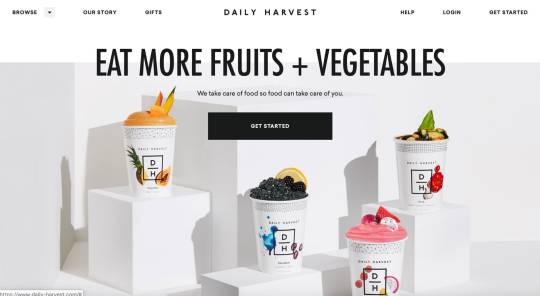
The heading ‘Eat More Fruits + Vegetables’ speaks to the target customers desire to boost their diet with healthy ingredients
The subheading ‘We take care of food so food can take care of you’ also taps into the same desires, but from a slightly different level, letting customers know that all the hard work — sourcing and preparing healthy foods — is done for them.
If you’ve ever interacted with the brand before the imagery on its site also feels incredibly familiar.
Daily Harvest has done a great job of creating its own unique brand style:
Crisp images of its packaging containing bold, brightly colored ingredients, photographed against a solid background. It also uses lighting to create shadows quite frequently.
Here’s its look on Instagram —

— and on a product page:
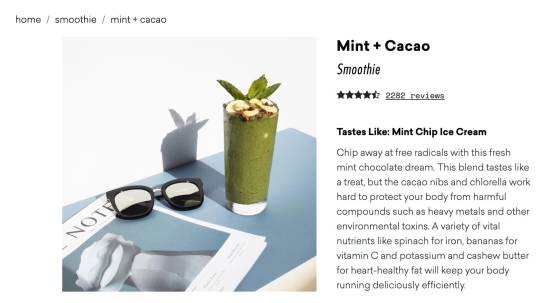
Expansion is also important for most DTC brands. Many launch with one or two specific products — for example, Casper mattresses — and expand into other related products in order to grow — Casper’s pillows and bed frames.
Daily Harvest is no different. It started out by selling frozen smoothie packs. But now it boasts a range of products.
And when it comes to launching new products, Daily Harvest ensures it keeps its focus on solving the problem of making healthy eating easier for consumers.
“It’s easy to observe their focus by taking stock of the product line expansions over the last couple years,” shares Marandiz. “They started with smoothies, but have moved into Harvest Bowls, Soups, Lattes, Chia Bowls, and Oat Bowls.”
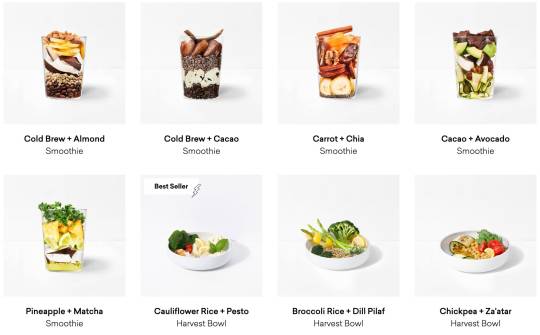
The messaging around each of its expansion products is also hyper-focused on customer goals.
Take its Harvest Bowls category page for example —
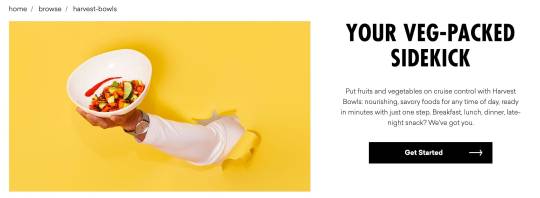
— the copy here continues to focus on the core mission of Daily Harvest: Making healthy eating simple. And no matter where you interact with the brand, that message remains consistent.
2. Use Pinterest as a discovery engine to reach millions of potential customers each month
Pinterest is somewhat of a sleeper in the social media world. And though it might not make as much noise as platforms like Facebook or Instagram, its power to help brands connect with consumers is undeniable.
In its S-1 filing ahead of going public, the company shared some insights into how people use the platform:
Pinners don’t just dream about their futures; they explore real options and often want to bring their dreams to life. They browse ideas, visit merchant websites and eventually buy products and services; and
People seeking inspiration use Pinterest in ways that mirror how they use magazines and catalogs.
So whereas consumers used to flick through magazines to find inspiration, they now turn to Pinterest — and this is why it has become such an incredible discovery engine for brands.
Daily Harvest has 5,638 followers on Pinterest. That doesn’t sound a lot, especially when compared to its audiences on Facebook (260k) and Instagram (406k). But follower numbers are just a small part of the equation.
On Pinterest, discoverability is far more important than the number of followers.
Daily Harvest racks up a mouthwatering 4.1m monthly unique viewers on Pinterest — meaning its Pins appear on over four million screens per month, and it does this having just 136 Pins.
Pinterest trends: Daily Harvest is in the perfect position to succeed on Pinterest. ‘Healthy habits’ is one of Pinterest’s trends for 2019, with searches for nutrition plans +475% year-on-year, showing that health-conscious consumers are using Pinterest to help them hit their goals.
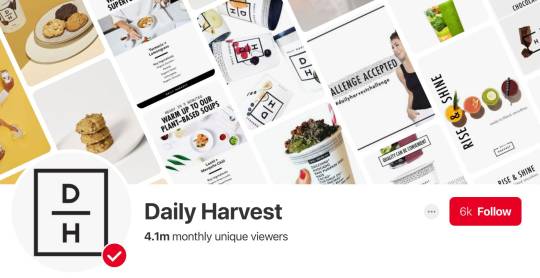
Its Pins tend to focus directly on Daily Harvest products in its brand style of stunning product imagery against a solid, light background:

According to SimilarWeb data, Pinterest is Daily Harvest’s third-highest refer amongst social networks, driving around 13,000 visits per month —
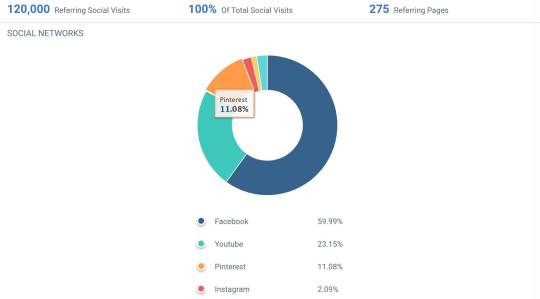
— and much of this traffic is going directly to product pages (the link on each Pin takes the viewer to the corresponding page):

3. Create a simple-to-navigate website and tell an engaging story to generate backlinks
SimilarWeb estimates that over 30% of Daily Harvest’s traffic comes from search —

— that’s a pretty large chunk, and if SimilarWeb’s estimates are correct, that search traffic equates to around 270,000 visits per month for the brand. That’s a lot of potential customers.
So what can we take away from Daily Harvest’s search success?
Firstly, usability and design are important:
“The design, first of all, is obviously incredible. While I never consider design to be a direct SEO factor, having a positive experience on a site does make you more likely to talk about and link to it,” says Glen Allsopp, SEO consultant and founder of Detailed.com.
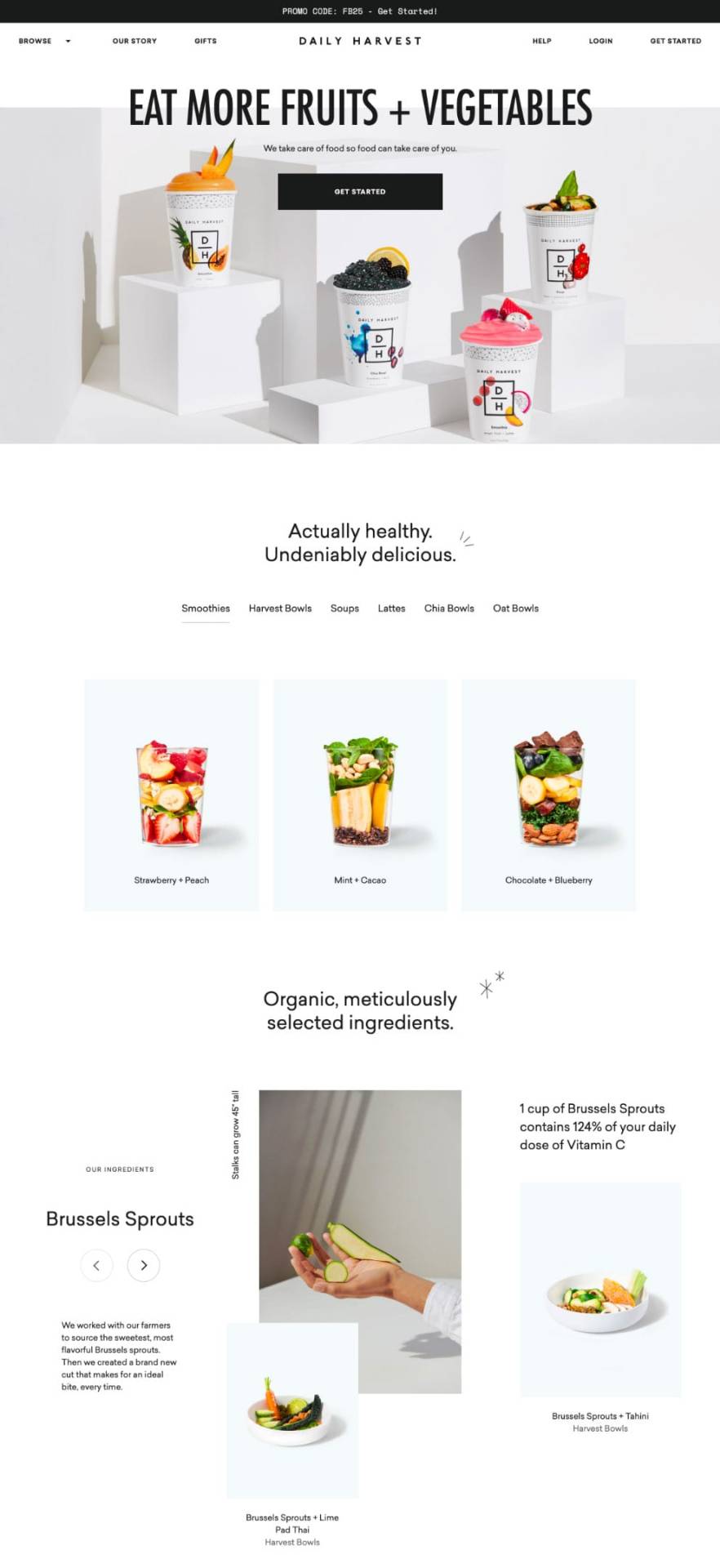
And Allsopp certainly isn’t alone in praising Daily Harvest’s design, Unbounce has also featured it in its roundup of companies that have created best-in-class landing pages.
But back to SEO…
Simplicity is somewhat of a theme for Daily Harvest across its website, content and even its products — pre-made, healthy meals that are ready in minutes.
And this theme carries over into its approach to SEO.
“I like that their URLs are short and descriptive, which is in line with their title tags as well,” notes Allsopp. “Title tags don’t get much more simple and clean than ‘Lentil + Mesquite Soup | Daily Harvest’.”
Daily Harvest also manages to include plenty of information on its product pages, something that’s not easy to do well Allsopp told me. First, each product has a short description right under the title —
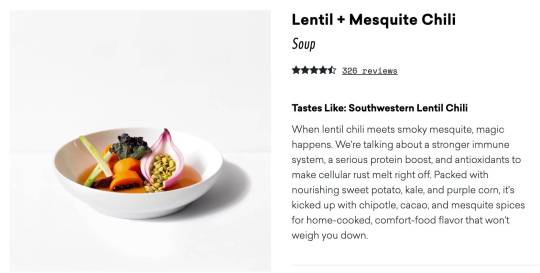
— a little further down the page, visitors can see key ingredients, nutrition information and preparation instructions — essentially everything a customer would want to know about this product, without it feeling overwhelming:
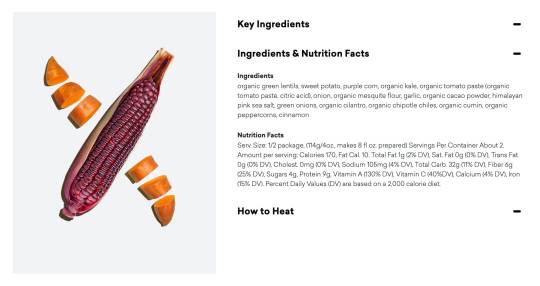
One downside to Daily Harvest’s beautiful imagery is the effect it has on load times. “According to Google’s mobile site speed comparison tool, it’s a lot slower than competitors sites,” Allsopp shared.
But with much of its search traffic coming in via branded searches, Daily Harvest has done a great job building its brand and creating a loyal customer base:
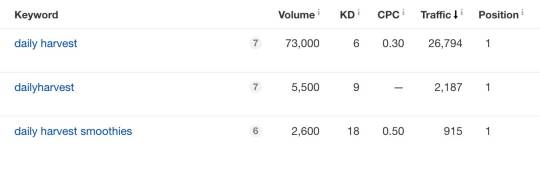
Possibly Daily Harvest’s biggest SEO-win is the quality of backlinks it has been able to obtain from leading publications — something that’s a challenge for almost every business.
Link building is one of the hardest aspects of SEO — and I have no insider knowledge here — but I’d bet Daily Harvest has never sent out a batch of emails asking marketers to backlink to its site.
Instead, it does link building the right way, by telling its story… and having a great product.
“Daily Harvest’s founder, Rachel Drori, has been great at getting quoted in big publications,” Allsopp told me. “Some places that have asked her for comment include CNBC and The New York Times. Those aren’t easy links to get, so they’re likely to help the site for a long time to come.”

Because its products are high-quality and deliver on what it promises, it’s enabled Daily Harvest to be featured by industry experts and pick up links from high-authority sites like MSN:
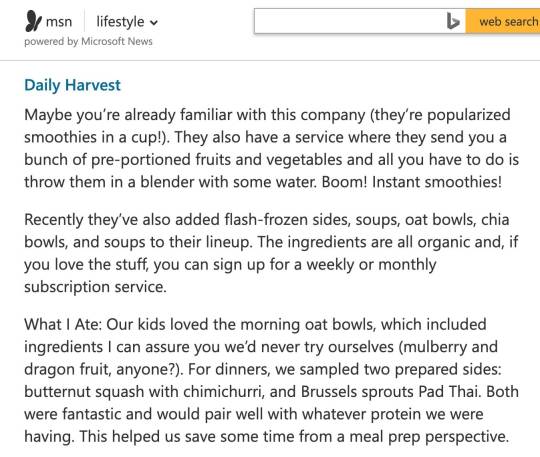
“While they still have improvements to make with their on-site SEO, that’s always a great position to be in. Seeing opportunities for improvement there means there’s a good chance of growing organic traffic across the board going forward as well,” said Allsopp.
4. Use paid social to drive traffic to campaign-specific landing pages
When Daily Harvest runs ads, it doesn’t direct people to its homepage. Instead, it has a specially created landing page aimed to convert visitors to customers.
This isn’t a unique strategy. In-fact, creating specific landing pages for ads is a best practice for any brand investing in paid media. But the way Daily Harvest executes it is remarkable.
Here’s one of the brand’s landing pages:
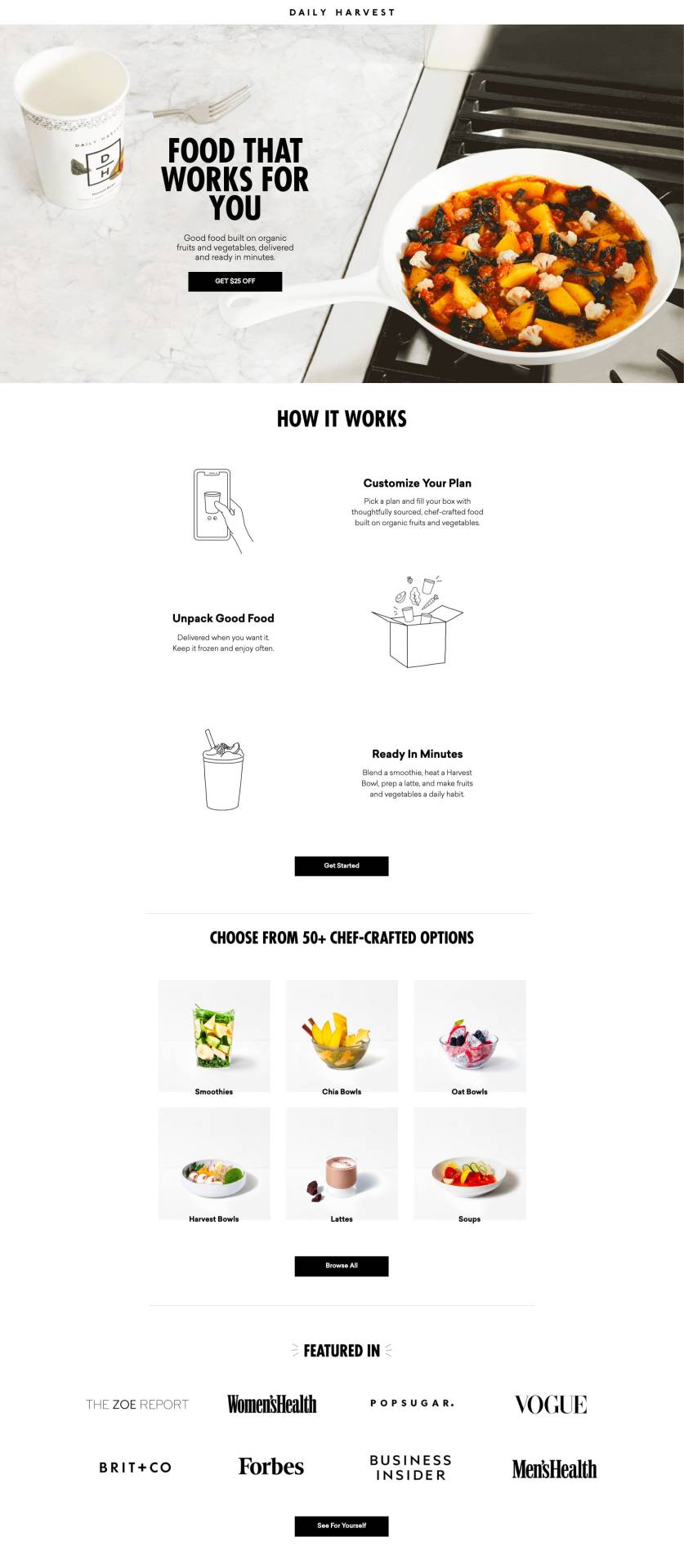
Keeping in line with Daily Harvest’s beautiful design aesthetic, the page looks super-clean and simple. But when you really dig in, there’s a lot going on.
Here are four takeaways from Daily Harvest’s landing page:
1. The hero copy builds on ad promises
Let’s start by breaking down the hero section at the top of the page:
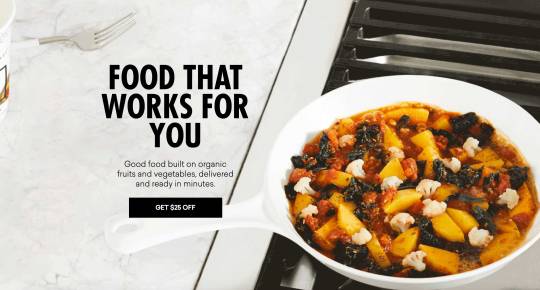
Daily Harvest is running a bunch of ads across Facebook and Instagram, and many of its ads are focused on these key messages:
Custom food plans
Quality, organic fruits and vegetables
Speed of preparation
Here are a few variations of that messaging in ad form:
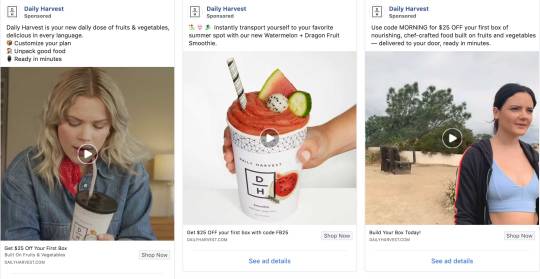
Once someone has clicked one of these ads, they arrive at one of Daily Harvest’s landing pages and the copy builds on the key points mentioned in the ads. It reinforces that:
The food is high quality, and good for you
It’s ready in minutes
Health eating that fits your routine
2. The CTA offer is very clear
In each of its ads, Daily Harvest mentions that new customers can get $25 off their first box using a promo code —
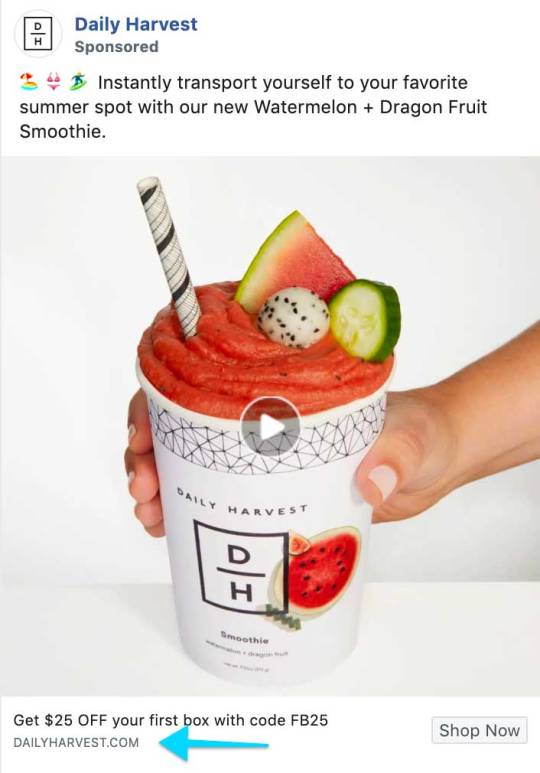
— and when they reach the landing page, this 25% offer is featured in the hero section CTA:

This makes the buyer journey feel super smooth as promises that were made in the first part of the journey (the ads) are being backed up as people move through the buying experience.
3. The copy is all about you, the customer
As the visitor scrolls through the landing page they reach a ‘How it works’ section:

The first title tag ‘Customize Your Plan’ puts the emphasis on you, the potential customer, and throughout this section of the landing page the reader is constantly reminded that Daily Harvest is a product that can solve your unmet needs.
Here are a few snippets of copy (emphasis mine):
Pick a plan and fill your box with thoughtfully sourced, chef-crafted food
Delivered when you want it
Make fruits and vegetables a daily habit
This copy also fulfils a need to let the customer know exactly how the process works. Many visitors want a hassle-free way to consume healthier foods, but prior to visiting this page may not understand how Daily Harvest delivers on this.
Pay attention to the small details: Microcopy — the small pieces of text that provide extra information and provide context across websites and interfaces — is incredibly important, and can have a big influence on clicks and conversions.
For example, one company found that changing the phrase “Request a quote” to “Request pricing” resulted 161.66% increase in clicks to its lead gen form.
4. It uses social proof to back up its message
Social proof is a powerful sales tool and helps to build trust. As Alfred explains in his post on the subject:
“Often in situations where we are uncertain about what to do, we would assume that the people around us(experts, celebrities, friends, etc.) have more knowledge about what’s going on and what should be done.”
As a prospective Daily Harvest customer, I might not be an expert on healthy eating, I just know I want to eat healthier. So to back up its message, Daily Harvest features a range of well-known publishers that have covered its products to help build trust:
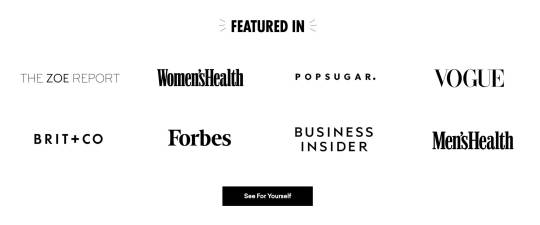
You’re more likely to put your faith in a health product featured by Men’s Health, Women’s Health and Vogue, than one no publisher has featured, right?
5. Build trust with new audiences through partnerships
Partnerships have become a key part of the direct-to-consumer marketing playbook.
Why?
In its simplest form, advertising is about connecting relevant audiences with your message. But when marketers focus purely on reach they run into a problem: reach has become a commodity — anyone can now create a Facebook ad and put it in front of an audience.
As Morgan Housel wrote —
Attracting eyeballs no longer sets you apart. Building trust among those who have their eyes on you, does. Getting people’s attention is no longer a skill. Keeping people’s attention is.
— and this is where partnerships come into their own: Building trust.
Let me explain…
When you follow a YouTuber, let’s say Casey Neistat, he’s built up your trust over hundreds (if not thousands) of hours of content and attention.
So when a brand like Samsung works with Casey, it helps the brand to build trust with Casey’s audience.
“If Samsung is cool with Casey, it’s cool with me.”

Daily Harvest takes a similar approach to partnerships….
YouTube drives significant traffic for Daily Harvest. You might recognize the below chart from earlier, but this time I’ve highlighted the YouTube numbers —
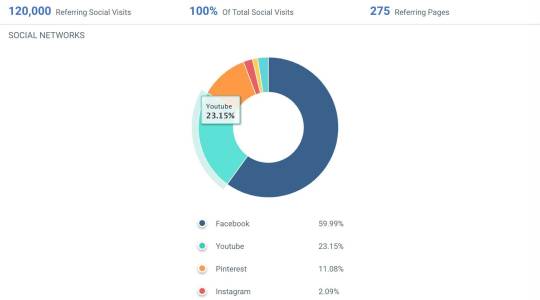
— around 23% of Daily Harvest’s social traffic comes from YouTube.
Curious as to why so many people come from YouTube to Daily Harvest I done a little digging… and it seems partnerships have a lot to do with it.
One the YouTube pages that appears to be sending a lot of traffic to Daily Harvest is from popular YouTuber, Wheezy Waiter (nearly 900k subs!):

The video (as you can probably guess from the above screenshot) is about the host’s experience trying out a vegan diet for a month.
And as the video progresses, the host runs into a problem with finding vegan desserts he likes. But Daily Harvest, the video’s sponsor, sent him 24 smoothies to help solve his problem:
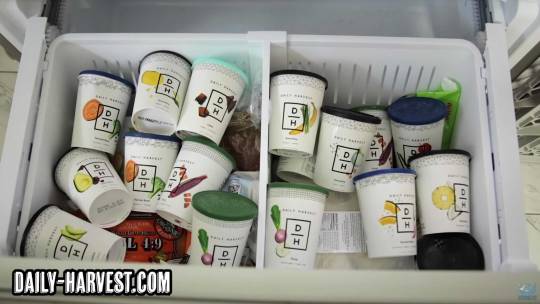
Incredible product placement (this video has been watched 1.5 million times and counting) but it doesn’t end there. In the video description there’s a link to Daily Harvest’s website:
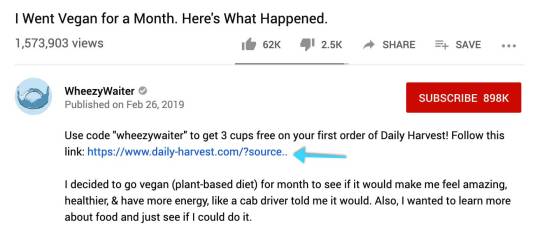
The link also has a UTM specific to Wheezy Waiter so the Daily Harvest team will be able to attribute traffic and sales to this partnership:
https://www.daily-harvest.com/?source=youtube&medium=cpc&campaign=inf&content=wheezywaiter&term=
Breaking down the UTM: Essentially, UTM codes tell the story of how traffic is arriving at a website. Here’s a breakdown of the Daily Harvest UTM:
source=youtube: This tells Daily Harvest the traffic has been referred by YouTube
medium=cpc: Says this was a cost-per-click campaign
content=wheezywaiter: Lets the Daily Harvest team know exactly which piece of content creator the traffic is came from
This is something Daily Harvest has done with a number of well-established YouTuber’s:
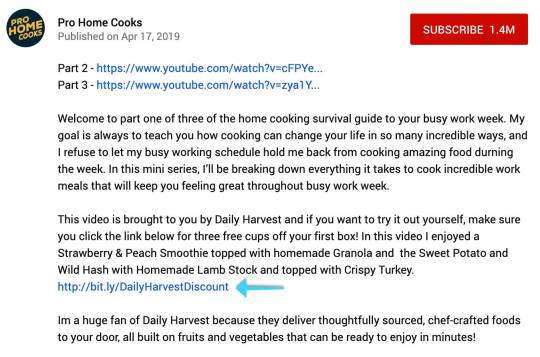
And:

But Daily Harvest’s partnerships aren’t limited to YouTube. It regularly runs Instagram takeovers with influencers and other brands in its stories —
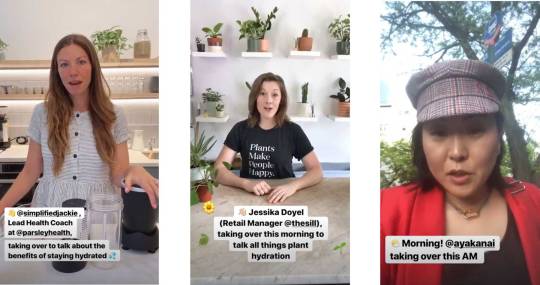
— and it also has an ambassador program enabling people with large followings to share exclusive discounts and coupon codes with their audiences:
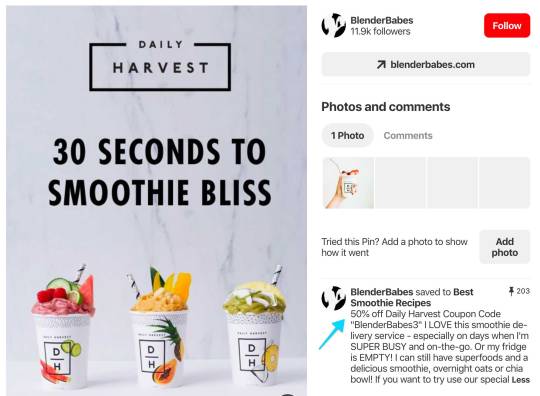
Daily Harvest is also very forthcoming with partnerships. Its website footer features a ‘Partnerships’ link:
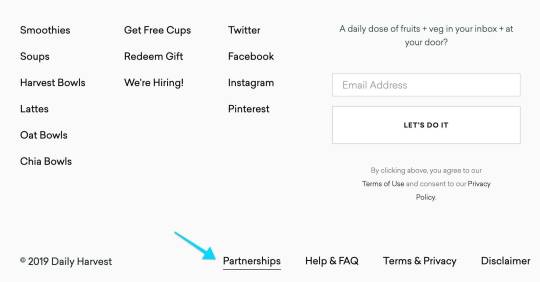
This link then takes people to a simple form where they can register their interest in working with the brand:
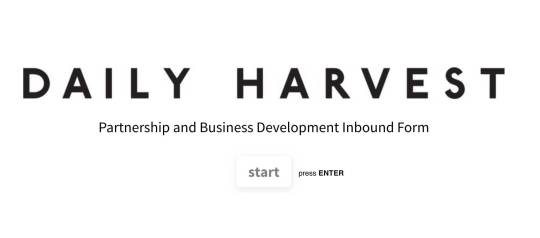
5 Takeaways from Daily Harvest’s journey to 100,000+ customers
1. Understand your target customer’s unmet needs:
Daily Harvest has a clear understanding of who its customer is exactly and what problems it solves for them. This influences how the whole business works: From its product lines to how it positions itself in the market.
2. Use Pinterest as a discovery engine:
Pinterest is a discovery engine for brands. People use Pinterest in ways that mirror how they use magazines and catalogs. By posting relevant content Daily Harvest reaches over four million people per month on the platform.
3. Create a beautiful, simple-to-use buying experience:
Consumers are spoilt for choice now, to stand out you need to create great experiences. Daily Harvest’s website does just that. Its focus on story has also helped the company to pick up some very important backlinks.
4. Drive paid social traffic to specific landing pages:
When using paid acquisition channels (especially on social media), Daily Harvest links to specific landing pages that build on the promises made in the ads.
5. Unlock new audiences through strategic partnerships:
When you’re marketing to new audiences, it’s not so much about reach as it is building trust. Daily Harvest works with partners and influencers to help it establish trust with new potential customers.
Thank 5 Marketing Lessons from Daily Harvest’s Journey to Shipping One Million Smoothies for first publishing this post.
0 notes
Text
Engagisuite Review Discount And Bonus
Introducing Engagisuite - WHAT IS IT?
Engagisuite is a cloud-based business growth system that can assist any business or specific expand their business. Every company can find usage for Engagisuite. With Engagisuitet you can;
Grow you r Facebook Audience
Grow your Instagram fans and interaction
Expand your Email List
Expand your Sales
Grow your Client Involvement
Grow your Ecommerce Shop
Expand your Mobile Application Users
Expand your Kickstarter as well as Indiegogo Funders
Grow your YouTube Audience
Grow your Physical Stores
Grow your Pinterest Follwers
Grow your LinkedIn Followers
and so far more
Engagisuite uses the power of Contests, Competition and also Instant Incentives to drive activity from your site visitors and potential customers.
With Engagisuite, you can develop Competitions, Competitions and deliver Instantaneous Incentives to your visitors to drive pertinent activities from your site visitors.
4 Contest Ideas That Will Help Quickly Expand Your Email List (Part 2)
Some popular variations you might examine consist of:
Picture or video clip contests. These are especially helpful for motivating user-generated material and also using the power of social media networks.
Event-based contests. Events that occur throughout the year, such as Valentine's Day, Mommy's Day, or Easter, are excellent opportunities to run a contest.
Polls/pick a prize. A "Select a Prize" contest is an interactive way to recognize even more about the kind of prize your leads are most interested in.
Giveaways or Drawing. The champion of this kind of Engagisuite contest is typically chosen at random from a swimming pool of participants, so every person has an equal opportunity to win.
Quizzes or Trivia. These contests take individuals on a trip that depends upon their answers to the questions.
# 4. Hand out something distinct as well as unique
Do you have something unique and unique you can free gift as your competition prize?
People enjoy obtaining the inside scoop or having "backstage" access to points that others don't. There is simply something about exclusivity that tickles our intrigue and also attracts action.
For example, Tootsie Roll, yes the company that concentrates on lollipop tastes as well as the traditional Tootsie Roll crunchy candy, launched a new lollipop taste as well as utilized a taste-testing competition to make sure the entire world found out about it. They organized a giveaway with the grand reward being the unusual possibility to be a taste tester for the new lollipop flavor.
Customers just needed to go to the competition's landing page and get in for a chance to be a preference tester by sharing their email address, name, posting address, as well as age. Using Facebook to market the contest, Tootsie Roll secured almost 44,000 entries in only 3 days!
The Aspects of a Successful Competition for Quickly Expanding Your Email Checklist
So, when it involves growth, what separates the effective contests from the failures?
To simplify, allow's take a better take a look at a competition held by Josh Earl, a freelance author and also designer.
Josh clearly did something right due to the fact that he was able to raise his email list by 3,418 percent in only 11 days.
Exactly how did he do this? Well, everything begun by supplying a product that related to the community and market he supplied a solution to.
However possibly a lot more notably, he targeted people that are on the internet all day long; this sort of target market is exceptionally beneficial when it concerns marketing and also advertising a giveaway.
Not only was his target market online all day, however they likewise had a tendency to share a whole lot on social media. He after that improved the sharing of his free gift by using clients added access for each time they shared the Engagisuite contest. And by using an automated drip email series to individuals, he urged candidates to gather much more entrances.
In recap, the most effective competitions for listing growth ...
Are laser-focused in that they target.
Leverage social media to enhance their reach.
Deal a reward that has actually a high regarded value with the perfect leads.
Are you ready to increase your email listing size by running a competition?
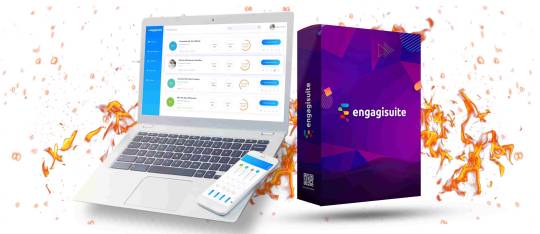
Engagisuite Testimonial & Summary
Supplier: Ugoo Carson et alia
Item: Engagisuite
Launch Day: 2019-Jun-24
Launch Time: 11:00 EDT
Front-End Rate: $67
JV Web page: https://www.socialleadfreak.com/engagisuite-review/
Niche: Software program
Engagisuite Quality & Advantages
Easy to Use User Interface:
The Engagisuite user interface is really easy to use, anyone can develop their initial project with little to no assistance.
Over 33 Feasible Individual Activities to Select From:
You get over 33 possible activities to add to your project relying on your campaign goal. You can drive even more application download, fans on Instagram, a lot more Kickstarter backers, viral share, even more Pinterest pins therefore a lot more.
Extremely Personalized Incentives:
Individuals can either giveaway a web link, a downloadable file or a coupon code. You're no more restricted to the kind of lead magnet you can use.
One-Click Social Engagement Suite:
With simply a click of a switch, your site visitors can follow you on social media sites, repost your material, show to buddies, remark and also far more without ever leaving your web page.
Effective Viral Share Collection:
Go viral with our one-click share feature. Allows visitors share your project with their audience on Facebook, Twitter, LinkedIn and even WhatsApp.
Easy Combination with Your Favorite Autoresponders:
Conveniently integrate with numerous autoresponders to expand your email quick.
One-Click Email Registration:
Build your email clients with authentic e-mails from their Facebook, Twitter, Google as well as Twitch accounts. No more stress over fake or misspelt email addresses
Mobile Optimized Project Pages:
Your visitors obtain the exact same abundant experience on your touchdown web page on mobile as well as tablet devices.
Embed on any kind of Site:
Easily embed your campaigns on your internet site so your site visitors don't need to leave your site to complete the campaign.
Automatic Messages to New clients as well as Entrants:
Setup automated messages to your customers when they get in on your contest, when they win or when they lose. No need for an autoresponder to communicate your new leads.
Powerful Geo-Restriction as well as Age-Restriction:
Limits participants by location for far better targeted leads. Add single or multiple nations at the same time. Restrict project by age to limit persons outside your required age restriction.
Rich Deep Campaign Analytics:
Obtain live comprehensive evaluation of your projects.
And a Lot of Various Other Powerful Features
Easy Data Export
Distinct Referral Hyperlinks
Full Cloning Functions, reuse your effective projects with a click of a button
Produce subuser management to your campaigns
Great deal of remade themes to obtain your started rapidly
Energetic Trusted Assistance
Complete training offered inside the application
Numerous Brand Name Administration
Engagisuite Rate & Assessment
FE - Engagisuite Main
The frontend deal includes the main gain access to as well as attributes of Engagisuite that enables customers to produce their very own viral campaigns, and expand their e-mail list.
OTO1 - Engagisuite Pro
Engagisuite PRO opens the accessibility to more extra functions:
- Autoresponder combination - Embed campaign on site - Even more pre-made layouts - Age Restriction for projects - More actions included - Complete Analytics - Mobile enabled projects - Geo-Intelligence - restrict campaigns by nation - Publish campaign pop-ups
OTO 2 - Agency Toolkit
Whatever your consumer requires to start up a list building agency companies. Consists of DFY web site, email swipes, phone-call swipes, FAcebook Campaigns, Lead Generation funnel etc.
OTO 3 - Engagisuite Agency
Transform Engagisuite to a full-fledged company application. Welcome team members as sub-users, develop as well as take care of campaigns unrestricted brands.
0 notes
Text
Evaluation
What primary research did I do?
For my primary research, I had to pick a audience to base my clothing around. I decided to go for around teen-early 20′s for my age group and researched brands that i personally liked as well as my peers. I had asked for opinions around the class on what brands they liked, and what styles they liked and wore on a day to day bases.
I have also visited the Walkers art gallery in Liverpool, to view the different art pieces for inspiration for my project. While viewing the work, I came across a bronze statue of Eve from 1902. This is what gave me my theme of the Adam and Eve story.
What secondary research did i do?
A lot of the secondary research is based around the internet and books. I started looking at clothing magazines (Example, EMP clothing) to give me an idea on what I’d like my clothes to look like. I stuck with clothing that young adults/ teenagers would want to wear, as that was my target audience. After looking at magazines, I direct my focus online, looking at various brands, both main stream and unknown. With the help of a few peers, I chose a selection of clothing apparels online to review and analyse on my blog.
I also read up on a book about netting, to help me prosecute how my packages would look like and work. Websites such as pinterest had also given me more ideas, such as 3D apples from my logo. The 3D apple was for my display, and to help my point of sale.
How did my research help me to develop ideas?
My research, both primary and secondary, have shaped my designs and official outcomes. The walkers art gallery trip inspired my theme due to the Adam and Eve sculptures and paintings that had throughout the gallery. My clothing brand research had helped me figure out what people other than me my age would like to wear as well as styles that are trending as of late in the media.
What artists have I looked at?
I focused mainly on traditional tattoo artists as a lot of my clothing brand designs have a traditional tattoo style. A few of the main tattoo artists I looked at were Homeslice Joey and Sailor Jerry. I decided to expand and look at more different artists, such as Natasha Law, European.son.420 and Fried Cactus Studio. This is just to compare with traditional designs so I could possibly mix and match different designs with the art style
How did they inspire and influence my work?
My main inspiration from the artists I looked at was Sailor Jerry and Homeslice Joey. These two tattoo artists focuses only on traditional tattoo designs which is the main theme of my clothing brand. The two artists style inspired almost all my designs and influenced how I drew certain things and pushed my to experiment with my illustrations to create unique outcomes.
The non traditional artists I looked such as european.son.420 and Shepard Fairey inspired to me experiment with my traditional tattoo style, and add twists of different art cultures in them.
What were my initial ideas and how have I developed these ideas/ changes to final outcomes?
My initial ideas was to keep it strictly traditional tattoo themed, producing designs for;
3 beanies
2 long sleeve shirts
3 t-shirts
3 bandanas
3 lanyards
1 hoodie
Throughout my designing process, I decided to design only one beanie due embroidery issues, and five shirts as I had more illustrations I wanted to include and wouldn’t be able to fit onto 3 shirts.
One design was completely changed from a Eve floral design, to the snake pocket t-shirt. This was because of the design being awkward, and not fitting the shirt exactly how I wanted it. I decided to change the design into something simple and effective. With the snake head design fitting onto a pocket, it would match my apple slice pocket design. This makes the brand look more professional and helps the design look like its not out of place.
What materials and techniques have I used?
The list of materials I used throughout the project are:
Matte black card and thread
Gildan clothing
Fabric vinyl
clear vinyl
transfer paper
blank badges
fabric ink and mesh
The card was used to produce packaging and black tags. For printing on the clothing, a heat press was used to print illustrations onto my shirts using transfer paper and cut out fabric vinyl for solid coloured designs. A digital embroidery machine was used to also produce a shirt and beanie hat. A badge maker and spare 55mm badge parts was used to create my badge designs. Those badge designs were also printed onto the clear vinyl so stickers could be made as well. The rest of the shirts were produced using screen printing with the design burnt into the mesh and black fabric paint for the line art colour.
My most successful technique was screen printing. When done right, the screen print can come out as a solid colour, with little to no texture that a screen print usually produces. While transfer paper leaves the visible sheen and plastic feeling over the design, screen printing leaves no odd texture and makes the shirt look professionally done and doesn’t look cheap.
Another successful technique/ material was the fabric vinyl. This type of printing is used across famous brands such as Adidas due to its clean, sleek appearance. There is no plastic edges like transfer paper when heat pressing vinyl, and easy to print onto clothes.
Are my final outcomes successful? How/Why? Why not?
I believe my final outcomes are successful because they fit the target audience that I have chosen to design for. A lot of the clothing styles I have produced can be found in multiple brands like Huf and OBEY due to keeping to the trend of what the younger generation likes to wear.
Each outcome was carefully designed and was produced with the materials and techniques that best fitted the illustrations. For example, anything that had more than 2-3 colours was printed using transfer paper as vinyl and screen print are difficult methods to use when using a multi-coloured design.
I also decided to experiment with a lot of my shirts, such as upside down text to make my clothing look more unique to attract my target audience.
What new skills, knowledge, techniques and processes have I learned?
A new skill I have learnt is Illustrator. Before this project, I did all my illustrations in photoshop due to the brush customisation and flexibility. I decided to use vectors and converted to illustrator to produce my designs for my clothing brand. I’m now more familiar with the program, and will continue to use for illustrations instead of photoshop for now on.
I have also learnt more on using equipment such as the laser cutter, digital embroidering machine and the heat press. With this new knowledge, I am able to use each machine with little to no help and will be able to use in the future for other products and outcomes.
Is there anything I could have done differently to make my project more successful?
One thing that would’ve made my project successful was more posters. The posters would’ve been added advertisement for my clothing brand, and would’ve made my art exhibition display more eye catching. My reasoning from not creating them was how overused they are as outcomes, and I wanted to focus more on my designing and packaging for my clothing.
I also should have also focused more on the labels for my clothing, so my brand name/theme could be found throughout the entire collection of clothing. This is used in clothing brands such as supreme and Obey. It’s a good way of further advertisement of a brand.
Did I meet the requirements of the project brief?
the basic requirements of the brief was to create a clothing brand that is appealing to young adults in the style of traditional tattoo, using bold lines, minimal colours and detailed.
The style I have used throughout my project is solemnly based around traditional tattoo designs. A lot of the illustrations are bold and feature a very minimalistic colour pallet.
0 notes
Photo

New Post has been published on https://fitnesshealthyoga.com/12-tips-for-growing-your-personal-training-client-list/
12 Tips for Growing Your Personal Training Client List


Establishing a thriving personal training business requires a consistent flow of both new and ongoing clients. If you’re a new personal trainer or don’t have as many clients as you’d like, focusing on getting more clients is likely a top priority.
Well, thanks to the interconnected world we now live in, landing clients for your personal training business is easier now than ever before. Here are our top 12 tips for growing your personal training client list.
1. Use Social Media To Its Fullest
Social media is fantastic for attracting more clients to your personal training business. But there’s a right and wrong way to approach online social media marketing. Many people assume that posting a picture of their physique every once in a while will help them gain more traction with their online presence.
Leveraging social media correctly will help establish your brand as an expert personal trainer as well as building trust with future prospects. Here are a few of the most effective strategies you can implement to skyrocket your social media efforts:
Provide value. Make it a habit to show your followers you’re highly educated. This can be done by giving them daily tips or tidbits of information in your caption under pictures, as a status update, or an instructional video.
Post regularly. Frequency is crucial on social media. If you want to grow a loyal fan base, you must stay top of mind by consistently posting informational, conversational, or entertaining content every day.
Have strong opinions. People resonate with others who are willing to stand for what they believe in. If you don’t agree with a specific fitness ideology, talk about why your methods are better and back it up with science or proof.
Stick to One or Two Platforms at a Time
Between Facebook, Twitter, Instagram, and Pinterest, you may feel like there’s never enough time to publish regularly on social media.
Instead of spreading your efforts thin by posting on all social media platforms, sticking to just one or two at a time will help you grow a larger following of people who know, trust, and like what you say and post.
As a personal trainer, Facebook and Instagram are a great place to start. Find the one or two platforms that resonate with your audience most, publish frequently, and ignore the rest until you’ve successfully built a community on that platform.
2. Gather an Email List and Write to Them Regularly
Many personal trainers tend to neglect one of their most valuable assets, their email list. Many successful business owners no matter what industry, will tell you the money is in the list.
Email is known as one of the most personal mediums that acts as a one-to-one conversation with your client or prospect.
If you aren’t yet building an email list, the best time to start is now. A great way to start is by creating a free download in exchange for their email. For example, you can give them a free one-week meal plan or workout regimen in a PDF format.
Once you have their email, start sending regular broadcast emails and when done correctly, you can promote your services in each email as long as they are receiving some form of value or entertainment in each email.
Using an email software like Aweber, MailChimp, or Active Campaign will allow you to send out emails to your entire list at once.
3. Publish Blog Posts and Helpful Articles
Every person who reads an article written by you is a potential client. The more value people get out of your articles, the more they see you as an authority in the health and fitness space.
One of the best ways to demonstrate your expertise to potential clients is by regularly publishing helpful articles on your own blog. Having a content marketing plan set in place for your own brand and posting frequently will prove to potential clients that you’re an expert in the industry.
4. Submit Guest Posts to Other Blogs in Your Industry
If your website doesn’t have any traffic yet, consider reaching out to other authorities in your specific niche and requesting to do a guest post. Having your article published on someone else’s blog allows you to tap into their audience which leads to more traffic to your own website.
Spend some time researching other personal trainers with an online presence in your niche and establish a mutually beneficial relationship.
Many personal training bloggers are more than happy to publish your article on their website because they benefit from showing their audience new content that they didn’t have to spend time writing themselves or money hiring a writer.
5. Use Video
Video is now the most engaging type of medium on the internet. When people see you providing value through video, it’s much easier to gain their trust over any other kind of post.
If you’re focusing your marketing efforts on Facebook, regularly streaming a live video of yourself answering questions is a great way to provide valuable information to your potential clients. Eventually, people will start recommending your page and you’ll have a steady stream of prospects tuning into your live streams where you can promote your services at the end.
Uploading videos of exercises and instructional videos on Youtube is also a great idea.
When you’re talking to a potential client, referring them to your Youtube videos will not only educate them on proper movements, but it also shows you care about getting them results, which could make them want to hire you as a trainer.
6. Brand Your Personal Training Approach
If you have a unique approach to fitness, consider packaging it up, naming it, and marketing it in a way that resonates with your target audience.
The most successful personal trainers have a unique twist and have branded their exercise strategies. For example, instead of telling your busy office worker clients that you’re putting them on a full-body workout program 3 times a week, tell them about your “Full Body Fat Burner” workout program instead.
When done correctly, people will start referring others to your branded fitness program which could skyrocket your personal training business.
7. Get Hyper-Specific on a Targeted Niche
It may seem like a good idea to work with anyone and everyone when you don’t have many clients. But by narrowing down your fitness niche and focusing on a smaller subset of people, it’s much easier to grow your client list.
Most people who are just getting into health and fitness usually have a specific interest, goal, or lifestyle that they’re after.
Telling others that you can help them lose weight by holding them accountable with a consistent workout regimen is too general. Instead, hone in on a laser-targeted audience. For example, you could brand yourself as the go-to personal trainer for older adults who are new to fitness and want to lose weight without having to leave their home.
It’s much easier to get known as an expert in the field if you have specialized knowledge in a smaller fitness niche rather than trying to be known as the personal trainer who just helps people lose weight.

8. Strategically Receive Referrals
Referral marketing is extremely popular in the personal training business. Word-of-mouth referrals are an extremely effective source of ongoing clients but relying on others to recommend your services may feel like something you have no control over.
Going above and beyond to get clients the results they’re after and having a fantastic experience working with you will increase the chances that your existing clients will tell their friends and family about you.
In addition, you can also network with other independent gyms, studios, and health clubs to see if they’re willing to refer leads to you. If you are just starting out and don’t have many connections, consider offering these business owners a monetary reward for each client you land as an incentive.
9. Advertise a Free Session
If you’re a brand new personal trainer, advertise free sessions at your local gym. Once you’ve demonstrated your expertise, you can begin to charge them after your free session if they like working with you.
If you already have existing clients, offer a one-time “bring a friend free” session for each of your clients. Adding a specific deadline to the “bring a friend free” pass is also a great idea. This will give your existing clients a sense of urgency and the chances they have someone tag along increases.
Your clients will be more than happy to bring their friends in and it’s your job to give them an experience so good they’ll want to work with you long-term.
10. Partner with Health and Wellness Businesses
Establishing new relationships in the health and fitness industry isn’t limited to your local gym. Think outside the box and consider partnering with other health and wellness businesses in your area.
For example, if your target audience consists of millennials who are health conscious, reach out to coffee shops, yoga studios, or juice bars and ask them if they’d be interested in having you come in once a week to host a donation-only fitness class on the weekend.
This will help attract more customers to the business owner’s store while at the same time allowing you to make relationships with potential clients.
11. Always Stay Ahead of the Education Curve
The health and fitness industry is constantly evolving. It’s your job as a personal trainer to stay up to date with the latest science and trends to ensure that your clients are getting their money’s worth.
Most personal training certifications also require continuing education to stay certified. Maintaining your certification makes you a more valuable personal trainer and demonstrates you’re an expert in the eyes of potential clients.
It’s also a great idea to further your education with specialized credentials. If you’re already a personal trainer, graduating in a specialized program such as core training, back injury, or strength and conditioning will help you gain an even larger client list.
12. Deliver Results
Helping your clients get the results they’re looking for should be your number one priority.
Not only will they want to continue working with you, but it will increase the chances that they refer your services to their friends and family.
Additionally, always speak to your client with the sole purpose of delivering results. People hire personal trainers to help them achieve a specific goal. Keep your communications as clear, concise, specific and simple as possible inside and outside of the gym.
For example, tell them exactly how many sessions they should be working with you per week to get the results they’re after and offer to lay out an entire month’s schedule with dates and times so you’re always on the same page.
During your actual training sessions, start off by explaining to them what exercises you’ll be covering and why. Help them feel comfortable and confident that your regimen is right for them. Try not to get too heavy on the fitness jargon and guide them into doing the workout correctly without getting into exercise terminology they may not know about.
Grow Your Client List With a Widespread Approach
Growing your client list is the key to establishing a successful personal training business.
If you’re a new personal trainer with little to no clients, the majority of your time should be spent on marketing your services. Choosing a few of the strategies explained above and implementing them into your business on a consistent basis will help you land more clients in no time.
Instead of relying on just one strategy, consider casting a wider net with your marketing plan by choosing three to four of the tips we laid out and work on it every day.
You’ll have peace of mind knowing you have multiple sources of leads coming your way without relying on just one prospecting method. This way, you’ll always have a constant source of potential clients from various platforms and mediums.

!function(f,b,e,v,n,t,s) if(f.fbq)return;n=f.fbq=function()n.callMethod? n.callMethod.apply(n,arguments):n.queue.push(arguments); if(!f._fbq)f._fbq=n;n.push=n;n.loaded=!0;n.version='2.0'; n.queue=[];t=b.createElement(e);t.async=!0; t.src=v;s=b.getElementsByTagName(e)[0]; s.parentNode.insertBefore(t,s)(window, document,'script', 'https://connect.facebook.net/en_US/fbevents.js'); fbq('init', '137840740203760'); fbq('track', 'PageView'); (function(d, s, id) var js, fjs = d.getElementsByTagName(s)[0]; if (d.getElementById(id)) return; js = d.createElement(s); js.id = id; js.src = "http://connect.facebook.net/en_US/all.js#xfbml=1&status=0"; fjs.parentNode.insertBefore(js, fjs); (document, 'script', 'facebook-jssdk'));
Source link
0 notes
Text
Builderall Affiliate Program The Simplest and Quickest Path To Success
The Builderall affiliate program could be the simplest and quickest path to fulfilling your dream of making a life changing income online?
If you've got a computer, laptop and an Internet connection?
You're good to go!
youtube
WHAT IS AFFILIATE MARKETING?
Affiliate marketing is a performance-based marketing system where a product vendor pays an "affiliate" a commission when someone buys their product. That "someone" having been referred to the vendor by the "affiliate."
And it all happens online: You have a web presence, usually a website, that you attract like-minded visitors to, where you "warm them up" to the idea that the product you're promoting (as an affiliate) is the perfect answer to their pressing problem or need.
That "product" could be physical (books, CDs, DVDs, clothing, jewelry, natural medicines, etc.) or digital (e-books, e-reports, software, online courses / trainings, etc.).
When your visitor clicks on your affiliate link (on your site) they are redirected to the vendor's site, where the vendor will close the sale; a lot easier after you've warmed them up! When your site visitor buys the vendor's product you get paid a commission.
For example, if the product cost $100 and you get, say, 50% commission, you'll get paid $50! And all for, basically, introducing someone with a pressing problem or need to someone who can fix that problem.
Affiliate marketing is ideal for beginners starting out online as it has a very low barrier to entry: it's a very simple process that doesn't need any particular technical skills, you don't have to have your own product, and it doesn't cost the earth to get started. In fact, you can get going for less than $20!
And, you don't have to do selling, or fulfillment, or keep stock, or deal with payment systems, and you don't have to deal with customers; the vendor does that.
All YOU need is an Internet connection and a computer / laptop and you're good to go.
AFFILIATE NETWORKS
Because affiliate marketing is so profitable for both affiliate and vendor, over the years many "affiliate networks" have sprung up to help both affiliates and vendors manage their affairs much more efficiently and easily.
Vendors can attract affiliates by advertising their products on these networks and affiliates can easily find products to promote. Once an affiliate decides to promote a certain product the network assigns an affiliate link / ID so that sales of that product can be linked back to the affiliate.
The affiliate network also takes on responsibility for managing the flow of money between vendor and affiliate either by electronic transfer or check. It also charges a small fee to both vendor and affiliate for the service.
There are many affiliate networks to choose from, but a beginner to affiliate marketing can easily get started with "ClickBank" and / or "Amazon."
GETTING STARTED WITH AFFILIATE MARKETING
1. Choose Your Niche and Product
The first step is to decide which niche you wish to operate in. A "niche" is a group of people with very similar interests, e.g. gout sufferers, broken relationships, looking for car insurance, how to make money online, etc. But, of course, it also has to have proven "buyers" in it in order to make money.
So how do you find a profitable niche with lots of profitable products you can promote?
A very quick way to do this is to search affiliate networks for niches that have several products that their stats tell you are selling well. If there are lots of products that are selling well, you now know that the niche is a profitable one, and, the buyers in that niche like those products.
In other words, there's no second guessing; you know for a fact that you can make money in that niche and you know for a fact which products are successful, unlike if you had to develop your own product!
Once you're happy with a product, you sign-up as an affiliate for it and are given a unique link that you place on your website. When a visitor clicks on that link they go to the vendor's sales page where, if they buy, you get paid the commission assigned to that product.
2. Get Your Domain Name
Before you setup your website you need to get a domain name based around your niche. For example, fastgoutcure.com, weightlossforseniors.com. Get the idea? This will become your website "address."
Two of the most popular domain registrars are "GoDaddy" and "NameCheap."
3. Get Hosting
Next, you need to get hosting for your website. This is where all your website files will be stored and secured. When someone enters your domain name in their browser they will be directed to your website.
There are very many web hosting companies out there, but you can't go far wrong as a newbie by going with "HostGator."
4. Set-Up Your Website
You then need to set-up your website. This needs to be highly relevant to, and laser-focused on, your chosen niche and product. For example, having a website about "arthritis" and trying to promote a product that cures "gout" will neither rank well in the search engines nor make sales.
Although gout and arthritis are linked medically, most people don't know that, so they'll be searching for "arthritis" solutions or "gout" solutions and Google will present webpages on their search results that reflect that. So always stay laser-focused!
You need a platform or specialist software to build your website. The most popular platform today by far is "WordPress" which is free. Most good hosting companies like HostGator allow you to select WordPress directly from within your hosting control panel in just a couple of clicks.
5. Add Great Content
There's a saying in marketing that "content is king!" I like to say that "GREAT content is king!" So the content on your website has to be highly relevant to, and laser-focused on, your niche, such that your site visitors get great value (and know they great value) from it.
For example, if your site is about "gout" you write content about what causes it, its symptoms, how it's diagnosed, how it's treated, any natural remedies, any specific diets, lifestyle changes, and so on. Give top tips, some recipes, the latest studies, news, etc. That is, keep adding "value."
6. Drive Traffic (Visitors)
Now, you can have the best website in the world, the best product(s) to promote that will definitely, absolutely, help your target audience; but, if nobody ever lands on your site, you might as well not have bothered!
So getting visitors (called "traffic" in Internet marketing) to your website is absolutely critical to your success and to helping all those people who are desperately searching for a solution to their problem.
There's basically two ways to get traffic; "pay for it" or "get it free."
Paid traffic is things like advertising on other niche websites, Google, Bing, Facebook, etc. You can also pay people who have large email lists in the same niche as you to send out a promotional email of yours to their list.
But paying for traffic may not be the best option when starting out because you really need to know what you are doing because it's very easy to get "burnt" when you don't.
Free traffic comes from things like Search Engine Optimization (SEO) which is the art of getting your website on page 1 of Google, Bing, and other search engines.
You can also get tons of free traffic from posting great content (with links back to your site) on Social Media platforms like Facebook, Twitter, Instagram, Pinterest, etc. When people click on your link they end up on your website.
You can produce simple, short, YouTube videos that can drive traffic to your site via your site link in the video description.
One very popular way to drive free traffic to your site is to post comments on blogs and forums in the same or similar niche to you.
Article Source: http://EzineArticles.com/9674709
The Builderall affiliate program could be the simplest and quickest path to fulfilling your dream of making a life changing income online?
0 notes
Text
Builderall Affiliate Program The Simplest and Quickest Path To Success
The Builderall affiliate program could be the simplest and quickest path to fulfilling your dream of making a life changing income online?
If you've got a computer, laptop and an Internet connection?
You're good to go!
youtube
WHAT IS AFFILIATE MARKETING?
Affiliate marketing is a performance-based marketing system where a product vendor pays an "affiliate" a commission when someone buys their product. That "someone" having been referred to the vendor by the "affiliate."
And it all happens online: You have a web presence, usually a website, that you attract like-minded visitors to, where you "warm them up" to the idea that the product you're promoting (as an affiliate) is the perfect answer to their pressing problem or need.
That "product" could be physical (books, CDs, DVDs, clothing, jewelry, natural medicines, etc.) or digital (e-books, e-reports, software, online courses / trainings, etc.).
When your visitor clicks on your affiliate link (on your site) they are redirected to the vendor's site, where the vendor will close the sale; a lot easier after you've warmed them up! When your site visitor buys the vendor's product you get paid a commission.
For example, if the product cost $100 and you get, say, 50% commission, you'll get paid $50! And all for, basically, introducing someone with a pressing problem or need to someone who can fix that problem.
Affiliate marketing is ideal for beginners starting out online as it has a very low barrier to entry: it's a very simple process that doesn't need any particular technical skills, you don't have to have your own product, and it doesn't cost the earth to get started. In fact, you can get going for less than $20!
And, you don't have to do selling, or fulfillment, or keep stock, or deal with payment systems, and you don't have to deal with customers; the vendor does that.
All YOU need is an Internet connection and a computer / laptop and you're good to go.
AFFILIATE NETWORKS
Because affiliate marketing is so profitable for both affiliate and vendor, over the years many "affiliate networks" have sprung up to help both affiliates and vendors manage their affairs much more efficiently and easily.
Vendors can attract affiliates by advertising their products on these networks and affiliates can easily find products to promote. Once an affiliate decides to promote a certain product the network assigns an affiliate link / ID so that sales of that product can be linked back to the affiliate.
The affiliate network also takes on responsibility for managing the flow of money between vendor and affiliate either by electronic transfer or check. It also charges a small fee to both vendor and affiliate for the service.
There are many affiliate networks to choose from, but a beginner to affiliate marketing can easily get started with "ClickBank" and / or "Amazon."
GETTING STARTED WITH AFFILIATE MARKETING
1. Choose Your Niche and Product
The first step is to decide which niche you wish to operate in. A "niche" is a group of people with very similar interests, e.g. gout sufferers, broken relationships, looking for car insurance, how to make money online, etc. But, of course, it also has to have proven "buyers" in it in order to make money.
So how do you find a profitable niche with lots of profitable products you can promote?
A very quick way to do this is to search affiliate networks for niches that have several products that their stats tell you are selling well. If there are lots of products that are selling well, you now know that the niche is a profitable one, and, the buyers in that niche like those products.
In other words, there's no second guessing; you know for a fact that you can make money in that niche and you know for a fact which products are successful, unlike if you had to develop your own product!
Once you're happy with a product, you sign-up as an affiliate for it and are given a unique link that you place on your website. When a visitor clicks on that link they go to the vendor's sales page where, if they buy, you get paid the commission assigned to that product.
2. Get Your Domain Name
Before you setup your website you need to get a domain name based around your niche. For example, fastgoutcure.com, weightlossforseniors.com. Get the idea? This will become your website "address."
Two of the most popular domain registrars are "GoDaddy" and "NameCheap."
3. Get Hosting
Next, you need to get hosting for your website. This is where all your website files will be stored and secured. When someone enters your domain name in their browser they will be directed to your website.
There are very many web hosting companies out there, but you can't go far wrong as a newbie by going with "HostGator."
4. Set-Up Your Website
You then need to set-up your website. This needs to be highly relevant to, and laser-focused on, your chosen niche and product. For example, having a website about "arthritis" and trying to promote a product that cures "gout" will neither rank well in the search engines nor make sales.
Although gout and arthritis are linked medically, most people don't know that, so they'll be searching for "arthritis" solutions or "gout" solutions and Google will present webpages on their search results that reflect that. So always stay laser-focused!
You need a platform or specialist software to build your website. The most popular platform today by far is "WordPress" which is free. Most good hosting companies like HostGator allow you to select WordPress directly from within your hosting control panel in just a couple of clicks.
5. Add Great Content
There's a saying in marketing that "content is king!" I like to say that "GREAT content is king!" So the content on your website has to be highly relevant to, and laser-focused on, your niche, such that your site visitors get great value (and know they great value) from it.
For example, if your site is about "gout" you write content about what causes it, its symptoms, how it's diagnosed, how it's treated, any natural remedies, any specific diets, lifestyle changes, and so on. Give top tips, some recipes, the latest studies, news, etc. That is, keep adding "value."
6. Drive Traffic (Visitors)
Now, you can have the best website in the world, the best product(s) to promote that will definitely, absolutely, help your target audience; but, if nobody ever lands on your site, you might as well not have bothered!
So getting visitors (called "traffic" in Internet marketing) to your website is absolutely critical to your success and to helping all those people who are desperately searching for a solution to their problem.
There's basically two ways to get traffic; "pay for it" or "get it free."
Paid traffic is things like advertising on other niche websites, Google, Bing, Facebook, etc. You can also pay people who have large email lists in the same niche as you to send out a promotional email of yours to their list.
But paying for traffic may not be the best option when starting out because you really need to know what you are doing because it's very easy to get "burnt" when you don't.
Free traffic comes from things like Search Engine Optimization (SEO) which is the art of getting your website on page 1 of Google, Bing, and other search engines.
You can also get tons of free traffic from posting great content (with links back to your site) on Social Media platforms like Facebook, Twitter, Instagram, Pinterest, etc. When people click on your link they end up on your website.
You can produce simple, short, YouTube videos that can drive traffic to your site via your site link in the video description.
One very popular way to drive free traffic to your site is to post comments on blogs and forums in the same or similar niche to you.
Article Source: http://EzineArticles.com/9674709
The Builderall affiliate program could be the simplest and quickest path to fulfilling your dream of making a life changing income online?
0 notes
Text
Builderall Affiliate Program The Simplest and Quickest Path To Success
The Builderall affiliate program could be the simplest and quickest path to fulfilling your dream of making a life changing income online?
If you've got a computer, laptop and an Internet connection?
You're good to go!
youtube
WHAT IS AFFILIATE MARKETING?
Affiliate marketing is a performance-based marketing system where a product vendor pays an "affiliate" a commission when someone buys their product. That "someone" having been referred to the vendor by the "affiliate."
And it all happens online: You have a web presence, usually a website, that you attract like-minded visitors to, where you "warm them up" to the idea that the product you're promoting (as an affiliate) is the perfect answer to their pressing problem or need.
That "product" could be physical (books, CDs, DVDs, clothing, jewelry, natural medicines, etc.) or digital (e-books, e-reports, software, online courses / trainings, etc.).
When your visitor clicks on your affiliate link (on your site) they are redirected to the vendor's site, where the vendor will close the sale; a lot easier after you've warmed them up! When your site visitor buys the vendor's product you get paid a commission.
For example, if the product cost $100 and you get, say, 50% commission, you'll get paid $50! And all for, basically, introducing someone with a pressing problem or need to someone who can fix that problem.
Affiliate marketing is ideal for beginners starting out online as it has a very low barrier to entry: it's a very simple process that doesn't need any particular technical skills, you don't have to have your own product, and it doesn't cost the earth to get started. In fact, you can get going for less than $20!
And, you don't have to do selling, or fulfillment, or keep stock, or deal with payment systems, and you don't have to deal with customers; the vendor does that.
All YOU need is an Internet connection and a computer / laptop and you're good to go.
AFFILIATE NETWORKS
Because affiliate marketing is so profitable for both affiliate and vendor, over the years many "affiliate networks" have sprung up to help both affiliates and vendors manage their affairs much more efficiently and easily.
Vendors can attract affiliates by advertising their products on these networks and affiliates can easily find products to promote. Once an affiliate decides to promote a certain product the network assigns an affiliate link / ID so that sales of that product can be linked back to the affiliate.
The affiliate network also takes on responsibility for managing the flow of money between vendor and affiliate either by electronic transfer or check. It also charges a small fee to both vendor and affiliate for the service.
There are many affiliate networks to choose from, but a beginner to affiliate marketing can easily get started with "ClickBank" and / or "Amazon."
GETTING STARTED WITH AFFILIATE MARKETING
1. Choose Your Niche and Product
The first step is to decide which niche you wish to operate in. A "niche" is a group of people with very similar interests, e.g. gout sufferers, broken relationships, looking for car insurance, how to make money online, etc. But, of course, it also has to have proven "buyers" in it in order to make money.
So how do you find a profitable niche with lots of profitable products you can promote?
A very quick way to do this is to search affiliate networks for niches that have several products that their stats tell you are selling well. If there are lots of products that are selling well, you now know that the niche is a profitable one, and, the buyers in that niche like those products.
In other words, there's no second guessing; you know for a fact that you can make money in that niche and you know for a fact which products are successful, unlike if you had to develop your own product!
Once you're happy with a product, you sign-up as an affiliate for it and are given a unique link that you place on your website. When a visitor clicks on that link they go to the vendor's sales page where, if they buy, you get paid the commission assigned to that product.
2. Get Your Domain Name
Before you setup your website you need to get a domain name based around your niche. For example, fastgoutcure.com, weightlossforseniors.com. Get the idea? This will become your website "address."
Two of the most popular domain registrars are "GoDaddy" and "NameCheap."
3. Get Hosting
Next, you need to get hosting for your website. This is where all your website files will be stored and secured. When someone enters your domain name in their browser they will be directed to your website.
There are very many web hosting companies out there, but you can't go far wrong as a newbie by going with "HostGator."
4. Set-Up Your Website
You then need to set-up your website. This needs to be highly relevant to, and laser-focused on, your chosen niche and product. For example, having a website about "arthritis" and trying to promote a product that cures "gout" will neither rank well in the search engines nor make sales.
Although gout and arthritis are linked medically, most people don't know that, so they'll be searching for "arthritis" solutions or "gout" solutions and Google will present webpages on their search results that reflect that. So always stay laser-focused!
You need a platform or specialist software to build your website. The most popular platform today by far is "WordPress" which is free. Most good hosting companies like HostGator allow you to select WordPress directly from within your hosting control panel in just a couple of clicks.
5. Add Great Content
There's a saying in marketing that "content is king!" I like to say that "GREAT content is king!" So the content on your website has to be highly relevant to, and laser-focused on, your niche, such that your site visitors get great value (and know they great value) from it.
For example, if your site is about "gout" you write content about what causes it, its symptoms, how it's diagnosed, how it's treated, any natural remedies, any specific diets, lifestyle changes, and so on. Give top tips, some recipes, the latest studies, news, etc. That is, keep adding "value."
6. Drive Traffic (Visitors)
Now, you can have the best website in the world, the best product(s) to promote that will definitely, absolutely, help your target audience; but, if nobody ever lands on your site, you might as well not have bothered!
So getting visitors (called "traffic" in Internet marketing) to your website is absolutely critical to your success and to helping all those people who are desperately searching for a solution to their problem.
There's basically two ways to get traffic; "pay for it" or "get it free."
Paid traffic is things like advertising on other niche websites, Google, Bing, Facebook, etc. You can also pay people who have large email lists in the same niche as you to send out a promotional email of yours to their list.
But paying for traffic may not be the best option when starting out because you really need to know what you are doing because it's very easy to get "burnt" when you don't.
Free traffic comes from things like Search Engine Optimization (SEO) which is the art of getting your website on page 1 of Google, Bing, and other search engines.
You can also get tons of free traffic from posting great content (with links back to your site) on Social Media platforms like Facebook, Twitter, Instagram, Pinterest, etc. When people click on your link they end up on your website.
You can produce simple, short, YouTube videos that can drive traffic to your site via your site link in the video description.
One very popular way to drive free traffic to your site is to post comments on blogs and forums in the same or similar niche to you.
Article Source: http://EzineArticles.com/9674709
The Builderall affiliate program could be the simplest and quickest path to fulfilling your dream of making a life changing income online?
0 notes
Text
Builderall Affiliate Program The Simplest and Quickest Path To Success
The Builderall affiliate program could be the simplest and quickest path to fulfilling your dream of making a life changing income online?
If you've got a computer, laptop and an Internet connection?
You're good to go!
youtube
WHAT IS AFFILIATE MARKETING?
Affiliate marketing is a performance-based marketing system where a product vendor pays an "affiliate" a commission when someone buys their product. That "someone" having been referred to the vendor by the "affiliate."
And it all happens online: You have a web presence, usually a website, that you attract like-minded visitors to, where you "warm them up" to the idea that the product you're promoting (as an affiliate) is the perfect answer to their pressing problem or need.
That "product" could be physical (books, CDs, DVDs, clothing, jewelry, natural medicines, etc.) or digital (e-books, e-reports, software, online courses / trainings, etc.).
When your visitor clicks on your affiliate link (on your site) they are redirected to the vendor's site, where the vendor will close the sale; a lot easier after you've warmed them up! When your site visitor buys the vendor's product you get paid a commission.
For example, if the product cost $100 and you get, say, 50% commission, you'll get paid $50! And all for, basically, introducing someone with a pressing problem or need to someone who can fix that problem.
Affiliate marketing is ideal for beginners starting out online as it has a very low barrier to entry: it's a very simple process that doesn't need any particular technical skills, you don't have to have your own product, and it doesn't cost the earth to get started. In fact, you can get going for less than $20!
And, you don't have to do selling, or fulfillment, or keep stock, or deal with payment systems, and you don't have to deal with customers; the vendor does that.
All YOU need is an Internet connection and a computer / laptop and you're good to go.
AFFILIATE NETWORKS
Because affiliate marketing is so profitable for both affiliate and vendor, over the years many "affiliate networks" have sprung up to help both affiliates and vendors manage their affairs much more efficiently and easily.
Vendors can attract affiliates by advertising their products on these networks and affiliates can easily find products to promote. Once an affiliate decides to promote a certain product the network assigns an affiliate link / ID so that sales of that product can be linked back to the affiliate.
The affiliate network also takes on responsibility for managing the flow of money between vendor and affiliate either by electronic transfer or check. It also charges a small fee to both vendor and affiliate for the service.
There are many affiliate networks to choose from, but a beginner to affiliate marketing can easily get started with "ClickBank" and / or "Amazon."
GETTING STARTED WITH AFFILIATE MARKETING
1. Choose Your Niche and Product
The first step is to decide which niche you wish to operate in. A "niche" is a group of people with very similar interests, e.g. gout sufferers, broken relationships, looking for car insurance, how to make money online, etc. But, of course, it also has to have proven "buyers" in it in order to make money.
So how do you find a profitable niche with lots of profitable products you can promote?
A very quick way to do this is to search affiliate networks for niches that have several products that their stats tell you are selling well. If there are lots of products that are selling well, you now know that the niche is a profitable one, and, the buyers in that niche like those products.
In other words, there's no second guessing; you know for a fact that you can make money in that niche and you know for a fact which products are successful, unlike if you had to develop your own product!
Once you're happy with a product, you sign-up as an affiliate for it and are given a unique link that you place on your website. When a visitor clicks on that link they go to the vendor's sales page where, if they buy, you get paid the commission assigned to that product.
2. Get Your Domain Name
Before you setup your website you need to get a domain name based around your niche. For example, fastgoutcure.com, weightlossforseniors.com. Get the idea? This will become your website "address."
Two of the most popular domain registrars are "GoDaddy" and "NameCheap."
3. Get Hosting
Next, you need to get hosting for your website. This is where all your website files will be stored and secured. When someone enters your domain name in their browser they will be directed to your website.
There are very many web hosting companies out there, but you can't go far wrong as a newbie by going with "HostGator."
4. Set-Up Your Website
You then need to set-up your website. This needs to be highly relevant to, and laser-focused on, your chosen niche and product. For example, having a website about "arthritis" and trying to promote a product that cures "gout" will neither rank well in the search engines nor make sales.
Although gout and arthritis are linked medically, most people don't know that, so they'll be searching for "arthritis" solutions or "gout" solutions and Google will present webpages on their search results that reflect that. So always stay laser-focused!
You need a platform or specialist software to build your website. The most popular platform today by far is "WordPress" which is free. Most good hosting companies like HostGator allow you to select WordPress directly from within your hosting control panel in just a couple of clicks.
5. Add Great Content
There's a saying in marketing that "content is king!" I like to say that "GREAT content is king!" So the content on your website has to be highly relevant to, and laser-focused on, your niche, such that your site visitors get great value (and know they great value) from it.
For example, if your site is about "gout" you write content about what causes it, its symptoms, how it's diagnosed, how it's treated, any natural remedies, any specific diets, lifestyle changes, and so on. Give top tips, some recipes, the latest studies, news, etc. That is, keep adding "value."
6. Drive Traffic (Visitors)
Now, you can have the best website in the world, the best product(s) to promote that will definitely, absolutely, help your target audience; but, if nobody ever lands on your site, you might as well not have bothered!
So getting visitors (called "traffic" in Internet marketing) to your website is absolutely critical to your success and to helping all those people who are desperately searching for a solution to their problem.
There's basically two ways to get traffic; "pay for it" or "get it free."
Paid traffic is things like advertising on other niche websites, Google, Bing, Facebook, etc. You can also pay people who have large email lists in the same niche as you to send out a promotional email of yours to their list.
But paying for traffic may not be the best option when starting out because you really need to know what you are doing because it's very easy to get "burnt" when you don't.
Free traffic comes from things like Search Engine Optimization (SEO) which is the art of getting your website on page 1 of Google, Bing, and other search engines.
You can also get tons of free traffic from posting great content (with links back to your site) on Social Media platforms like Facebook, Twitter, Instagram, Pinterest, etc. When people click on your link they end up on your website.
You can produce simple, short, YouTube videos that can drive traffic to your site via your site link in the video description.
One very popular way to drive free traffic to your site is to post comments on blogs and forums in the same or similar niche to you.
Article Source: http://EzineArticles.com/9674709
The Builderall affiliate program could be the simplest and quickest path to fulfilling your dream of making a life changing income online?
0 notes
Text
Builderall Affiliate Program The Simplest and Quickest Path To Success
The Builderall affiliate program could be the simplest and quickest path to fulfilling your dream of making a life changing income online?
If you've got a computer, laptop and an Internet connection?
You're good to go!
youtube
WHAT IS AFFILIATE MARKETING?
Affiliate marketing is a performance-based marketing system where a product vendor pays an "affiliate" a commission when someone buys their product. That "someone" having been referred to the vendor by the "affiliate."
And it all happens online: You have a web presence, usually a website, that you attract like-minded visitors to, where you "warm them up" to the idea that the product you're promoting (as an affiliate) is the perfect answer to their pressing problem or need.
That "product" could be physical (books, CDs, DVDs, clothing, jewelry, natural medicines, etc.) or digital (e-books, e-reports, software, online courses / trainings, etc.).
When your visitor clicks on your affiliate link (on your site) they are redirected to the vendor's site, where the vendor will close the sale; a lot easier after you've warmed them up! When your site visitor buys the vendor's product you get paid a commission.
For example, if the product cost $100 and you get, say, 50% commission, you'll get paid $50! And all for, basically, introducing someone with a pressing problem or need to someone who can fix that problem.
Affiliate marketing is ideal for beginners starting out online as it has a very low barrier to entry: it's a very simple process that doesn't need any particular technical skills, you don't have to have your own product, and it doesn't cost the earth to get started. In fact, you can get going for less than $20!
And, you don't have to do selling, or fulfillment, or keep stock, or deal with payment systems, and you don't have to deal with customers; the vendor does that.
All YOU need is an Internet connection and a computer / laptop and you're good to go.
AFFILIATE NETWORKS
Because affiliate marketing is so profitable for both affiliate and vendor, over the years many "affiliate networks" have sprung up to help both affiliates and vendors manage their affairs much more efficiently and easily.
Vendors can attract affiliates by advertising their products on these networks and affiliates can easily find products to promote. Once an affiliate decides to promote a certain product the network assigns an affiliate link / ID so that sales of that product can be linked back to the affiliate.
The affiliate network also takes on responsibility for managing the flow of money between vendor and affiliate either by electronic transfer or check. It also charges a small fee to both vendor and affiliate for the service.
There are many affiliate networks to choose from, but a beginner to affiliate marketing can easily get started with "ClickBank" and / or "Amazon."
GETTING STARTED WITH AFFILIATE MARKETING
1. Choose Your Niche and Product
The first step is to decide which niche you wish to operate in. A "niche" is a group of people with very similar interests, e.g. gout sufferers, broken relationships, looking for car insurance, how to make money online, etc. But, of course, it also has to have proven "buyers" in it in order to make money.
So how do you find a profitable niche with lots of profitable products you can promote?
A very quick way to do this is to search affiliate networks for niches that have several products that their stats tell you are selling well. If there are lots of products that are selling well, you now know that the niche is a profitable one, and, the buyers in that niche like those products.
In other words, there's no second guessing; you know for a fact that you can make money in that niche and you know for a fact which products are successful, unlike if you had to develop your own product!
Once you're happy with a product, you sign-up as an affiliate for it and are given a unique link that you place on your website. When a visitor clicks on that link they go to the vendor's sales page where, if they buy, you get paid the commission assigned to that product.
2. Get Your Domain Name
Before you setup your website you need to get a domain name based around your niche. For example, fastgoutcure.com, weightlossforseniors.com. Get the idea? This will become your website "address."
Two of the most popular domain registrars are "GoDaddy" and "NameCheap."
3. Get Hosting
Next, you need to get hosting for your website. This is where all your website files will be stored and secured. When someone enters your domain name in their browser they will be directed to your website.
There are very many web hosting companies out there, but you can't go far wrong as a newbie by going with "HostGator."
4. Set-Up Your Website
You then need to set-up your website. This needs to be highly relevant to, and laser-focused on, your chosen niche and product. For example, having a website about "arthritis" and trying to promote a product that cures "gout" will neither rank well in the search engines nor make sales.
Although gout and arthritis are linked medically, most people don't know that, so they'll be searching for "arthritis" solutions or "gout" solutions and Google will present webpages on their search results that reflect that. So always stay laser-focused!
You need a platform or specialist software to build your website. The most popular platform today by far is "WordPress" which is free. Most good hosting companies like HostGator allow you to select WordPress directly from within your hosting control panel in just a couple of clicks.
5. Add Great Content
There's a saying in marketing that "content is king!" I like to say that "GREAT content is king!" So the content on your website has to be highly relevant to, and laser-focused on, your niche, such that your site visitors get great value (and know they great value) from it.
For example, if your site is about "gout" you write content about what causes it, its symptoms, how it's diagnosed, how it's treated, any natural remedies, any specific diets, lifestyle changes, and so on. Give top tips, some recipes, the latest studies, news, etc. That is, keep adding "value."
6. Drive Traffic (Visitors)
Now, you can have the best website in the world, the best product(s) to promote that will definitely, absolutely, help your target audience; but, if nobody ever lands on your site, you might as well not have bothered!
So getting visitors (called "traffic" in Internet marketing) to your website is absolutely critical to your success and to helping all those people who are desperately searching for a solution to their problem.
There's basically two ways to get traffic; "pay for it" or "get it free."
Paid traffic is things like advertising on other niche websites, Google, Bing, Facebook, etc. You can also pay people who have large email lists in the same niche as you to send out a promotional email of yours to their list.
But paying for traffic may not be the best option when starting out because you really need to know what you are doing because it's very easy to get "burnt" when you don't.
Free traffic comes from things like Search Engine Optimization (SEO) which is the art of getting your website on page 1 of Google, Bing, and other search engines.
You can also get tons of free traffic from posting great content (with links back to your site) on Social Media platforms like Facebook, Twitter, Instagram, Pinterest, etc. When people click on your link they end up on your website.
You can produce simple, short, YouTube videos that can drive traffic to your site via your site link in the video description.
One very popular way to drive free traffic to your site is to post comments on blogs and forums in the same or similar niche to you.
Article Source: http://EzineArticles.com/9674709
The Builderall affiliate program could be the simplest and quickest path to fulfilling your dream of making a life changing income online?
0 notes